Australian parrots are so abundant and so diverse that nature documentaries often refer to Australia as The Land of Parrots. In fact, the southern continent even appeared under this name on a 1564 New World Map. It is hardly surprising that the early European explorers were so impressed by Australian parrots. After all, Australia is home to one-sixth of the world’s parrot species. Of about 330 parrot species that inhabit our planet, 56 are found in Australia.
So, why are there so many parrots in Australia?
Mainly because Australia’s geographic isolation allowed the parrots to diversify into a vast array of species and to colonise every corner of the continent in the absence of other large seed-eating birds. As a result, parrots are found in most Australian habitats, from the arid and semi-arid Outback to the humid coastal forests.
What types of parrots are found in Australia?
Australian parrots can be divided into two types or two families: cockatoos (Cacatidae family) and true parrots (Psittacidae family). Cockatoos are large striking birds typically with white or black plumage. True parrots are smaller and usually very colourful. In fact, they are among the brightest and most colourful birds in Australia.
When I first arrived in Australia, I was immediately captivated by these beautiful, cheeky birds that seemed so quincentennially Australian. I wanted to see as many different parrot species in Australia as I could. Over the years, I’ve been lucky to see a good variety of species, with just as many still remaining on my bucket list.
I put together this guide to Australian parrots for anyone interested in seeing these striking birds in their natural habitat or simply curious about all the different types of parrots in Australia. The images below are a mix of my own photographs, stock photos, and some images under Creative Commons licenses.
Australian Cockatoos
Cockatoos are large and long-lived parrots with a crest of feathers on top of their heads. Out of the world’s 21 species of cockatoo, Australia is home to 14 species (others are found in Papua New Guinea, Indonesia and the Philippines).
They are typically not as colourful as the smaller parrots. Four Australian cockatoos are white, six are black, two are pink, and the remaining two are multicoloured.
All Australian cockatoos nest in tree hollows, which means they depend on the presence of large old trees in the landscape to provide them with big enough hollows. Consequently, the loss of old-growth forests in Australia is the key threat to the continuing survival of Australian cockatoos.
Palm cockatoo
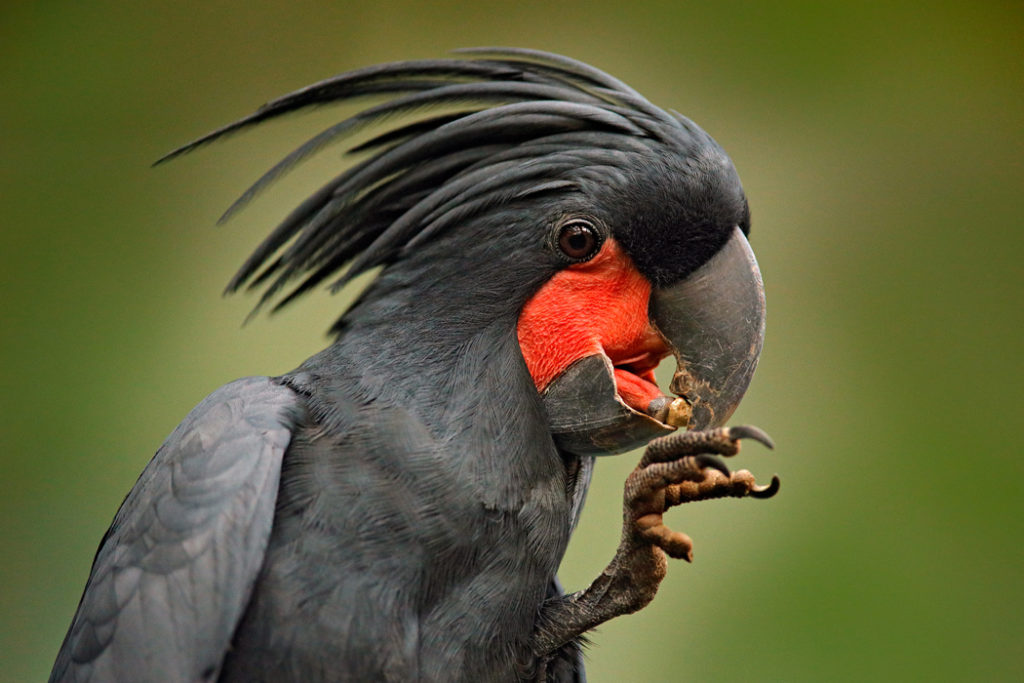
- Latin name: Probosciger aterrimus
- Conservation Status: Least Concern
With its large size, black plumage, red cheeks and long crest, the Palm cockatoo is the most striking Australian parrot. These regal birds grow to 55 to 60 cm in length and weigh up to 1.2 kg. Native to Cape York Peninsula (and New Guinea), the Palm cockatoo is one of the very few bird species that are known to use tools.
During the breeding season, male Palm cockatoo uses large sticks and seed pods to drum them against a dead tree and create a loud noise. The reason why the Palm cockatoos drum remains a mystery. Palm cockatoos usually travel in pairs or in flocks of 4-6 birds. You are most likely to see them flying above the canopy in Iron Ranges National Park.
Red-tailed black cockatoo
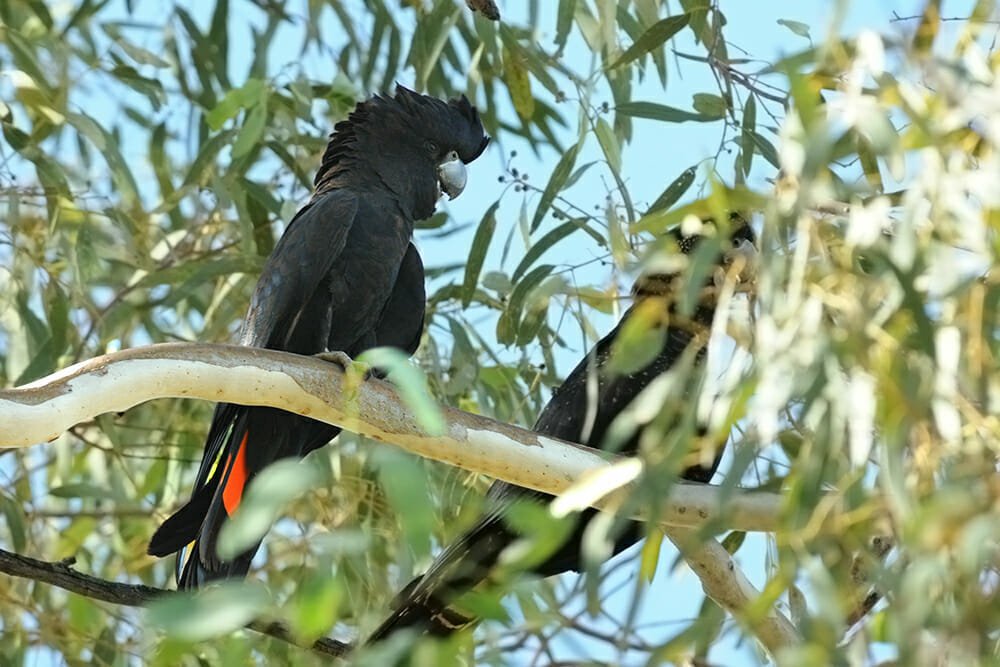
- Latin name: Calyptorhynchus banksii
- Conservation Status: Least Concern
Red-tailed black cockatoo is a magnificent large parrot (up to 60cm in length) with black plumage. Male birds have two bright red bars on the underside of their tails. They are more common in the northern parts of Australia, where they prefer eucalypt woodlands.
I’ve seen them throughout the north on a road trip from Adelaide to Darwin, including West Macdonnell Ranges, Old Andado, and Katherine Gorge. They also can be seen in inner Perth. These striking birds often congregate in large flocks, especially around water sources.
Glossy black cockatoo
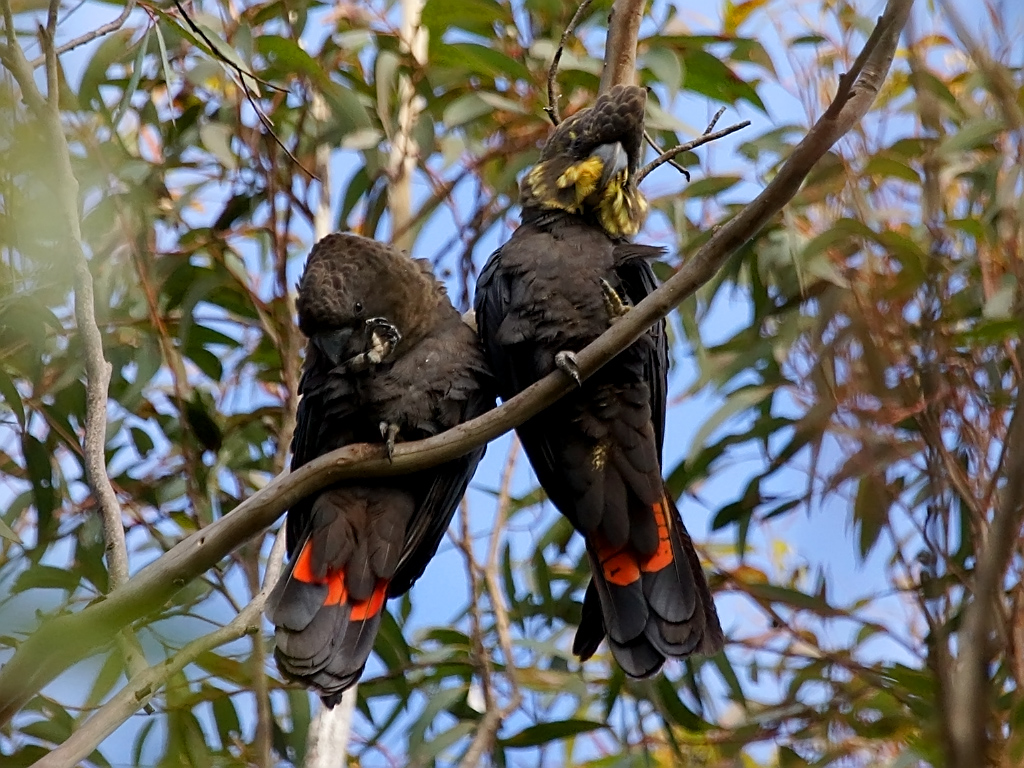
- Latin name: Calyptorhynchus lathami
- Conservation Status: Least Concern
The smallest (around 50 cm in length) of the black cockatoo species, the Glossy Black cockatoo occurs mainly in eastern Australia, from southeastern Queensland to eastern Victoria. You have a decent chance of seeing them along the Tweed coast.
There is also an outlying population on Kangaroo Island in South Australia, which is possibly the best place to see this species in the wild.
This cockatoo has a dark brown head and a black body. Males also have two red panels on their tails. They are usually found in open forest habitats, where they feed on seed pods of Casuarina trees.
Yellow-tailed black cockatoo
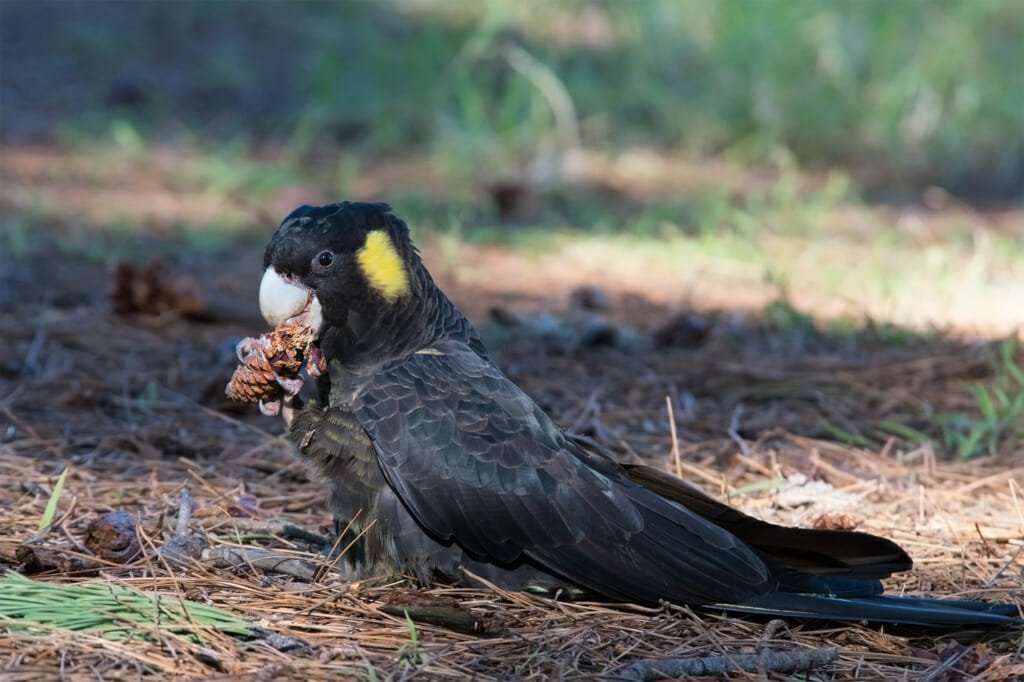
- Latin name: Zanda funerea
- Conservation Status: Least Concern
The Yellow-tailed Black-Cockatoo is a large parrot (55-60 cm in length) found in southeastern Australia, from the Eyre Peninsula in South Australia to the south and central eastern Queensland. They are distinct by their bright yellow cheeks and tail panels against uniform black plumage.
These cockatoos are quite common in and around Sydney. Some of the best places to see them are Centennial Park and Royal National Park, south of the city. Yellow-tailed black cockatoos often travel in large, noisy flocks as they feed on seed pods of various Australian native trees. We’ve seen some large flocks in Narooma.
Baudin’s black cockatoo
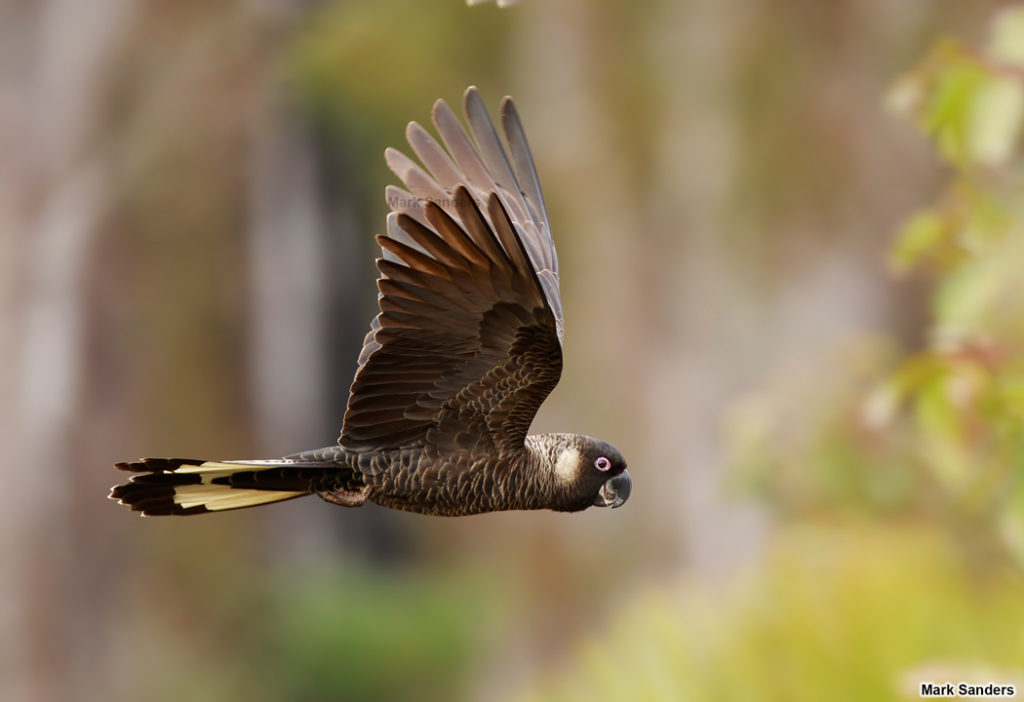
- Latin name: Zanda baudinii
- Conservation Status: Endangered
Baudin’s black cockatoo or Long-billed black cockatoo is a large (56 cm in length) parrot with white cheeks and tail panels on uniform black plumage. It is endemic to southwestern Australia, where it is sadly in decline.
Experts estimate that between ten and fifteen thousand individuals remain in the wild, and the species has been listed as Critically Endangered by IUCN in 2021. According to Kaarakun Black Cockatoo Conservation Centre, “flocks of Baudin’s can be found north to Gidgegannup, east to Wandering, only west as far as areas such as Midland, Gosnells, Byford, Bunbury and further south in Margaret River, the Stirling and Porongorup Ranges” where they prefer moist, heavily forested areas.
Carnaby’s black cockatoo
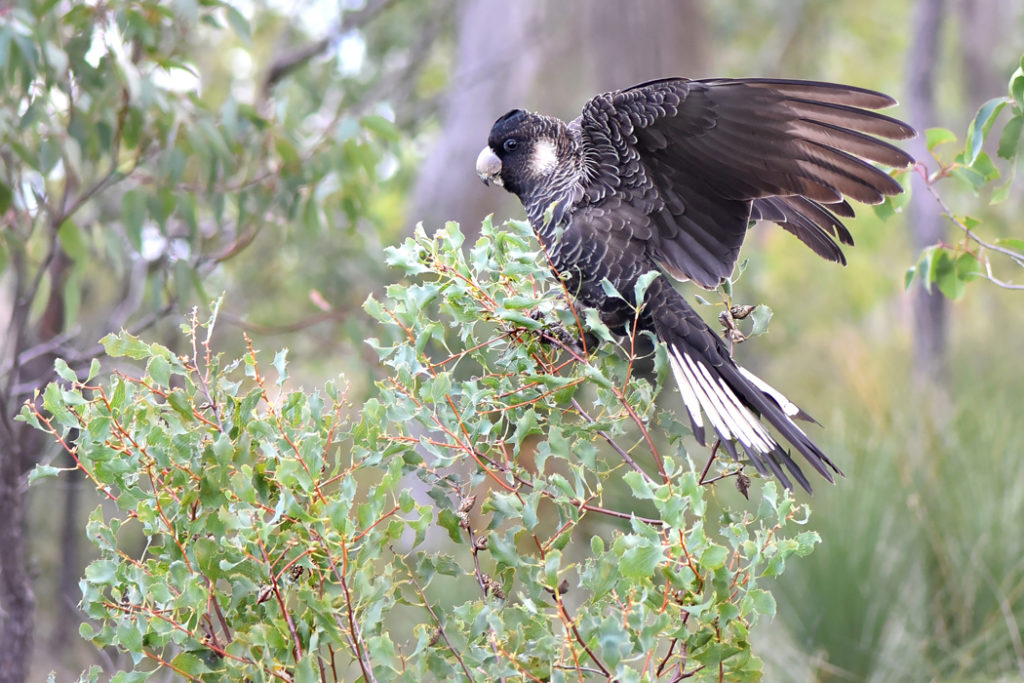
- Latin name: Zanda latirostris
- Conservation Status: Endangered
Similar in appearance to Baudin’s black cockatoo, Carnaby’s black cockatoo is another southwestern Australian endemic. Also known as the Short-billed black cockatoo, it is distinguished from its cousin by a shorter bill. The two species can be quite tricky to tell apart in the field.
Carnaby’s cockatoo nest in large hollows of old eucalypt trees. And since old-growth forests are disappearing across Australia, this species is in continuing decline. Swan Coastal Plain – a 30-km-wide stretch of coastline north of Perth is a good area to look for this species, as well as the Gnangara pine plantation in northern Perth.
Gang-gang cockatoo
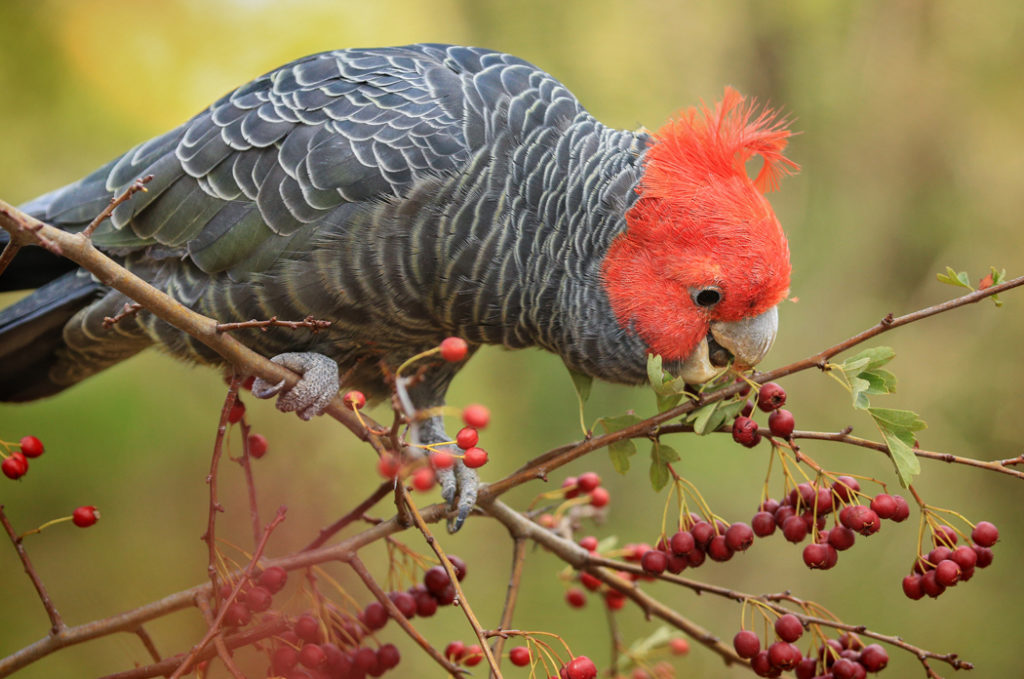
- Latin name: Callocephalon fimbriatum
- Conservation Status: Least Concert
Gang-gang is an adorable small cockatoo with grey plumage and bright red heads and crests in male birds. Endemic to coastal regions of southeastern Australia, Gang-gang prefers forest habitats and woodlands. They spend most of the year in the mountains, where they breed in the hollows of eucalypt trees, but in winter, they migrate to the lower elevations and more open habitats.
Canberra is a good place to look for gang gangs, as well as Mt Tomah botanic gardens in the Blue Mountains near Sydney.
Cockatiel
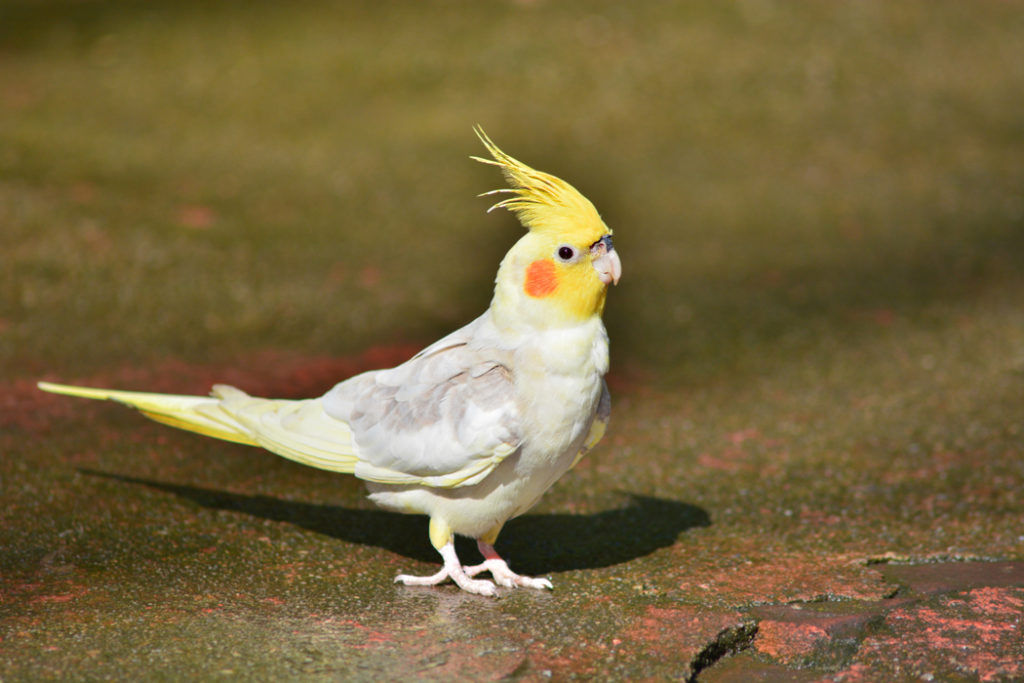
- Latin name: Nymphicus hollandicus
- Conservation Status: Least Concern
The cockatiel is the smallest member of the cockatoo family. It is a slender little bird that used to belong to the ‘true parrots’ family until recently. It is distinguished by its magnificent yellow crest and long tail.
Cockatiels occur primarily in the arid and semi-arid regions of Australia, where they lead a nomadic lifestyle following the availability of food and water. They travel mostly in small flocks but can congregate in large numbers around water sources.
Sulphur-crested cockatoo
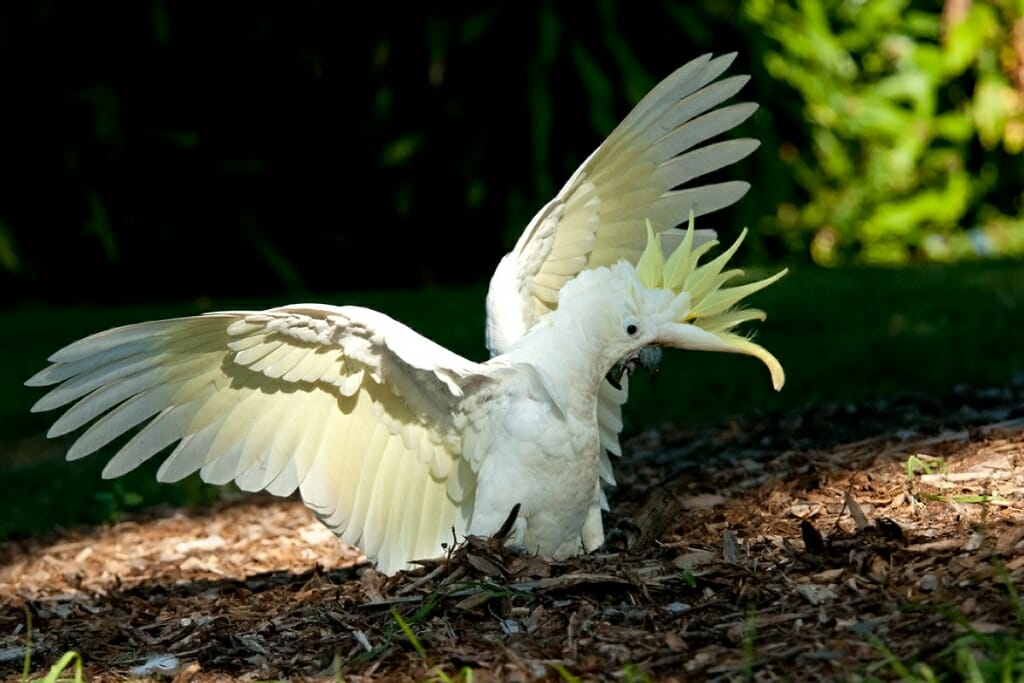
- Latin name: Cacatua galerita
- Conservation Status: Least Concern
With its spectacular yellow crest and snow-white plumage, the Sulphur-created cockatoo is perhaps the most familiar Australian parrot, forever associated with pirates and buried treasures. Common across much of the eastern coastline from the Kimberley to Tasmania, these large cockatoos are the pranksters of the parrot world.
They often swoop in with a laud racket and land bowing their heads and erecting their crests looking like royal jesters. I watched them play with sticks and leaves and carry on like drunken sailors, like in the image above, in Sydney’s Botanic Gardens.
Long-billed corella
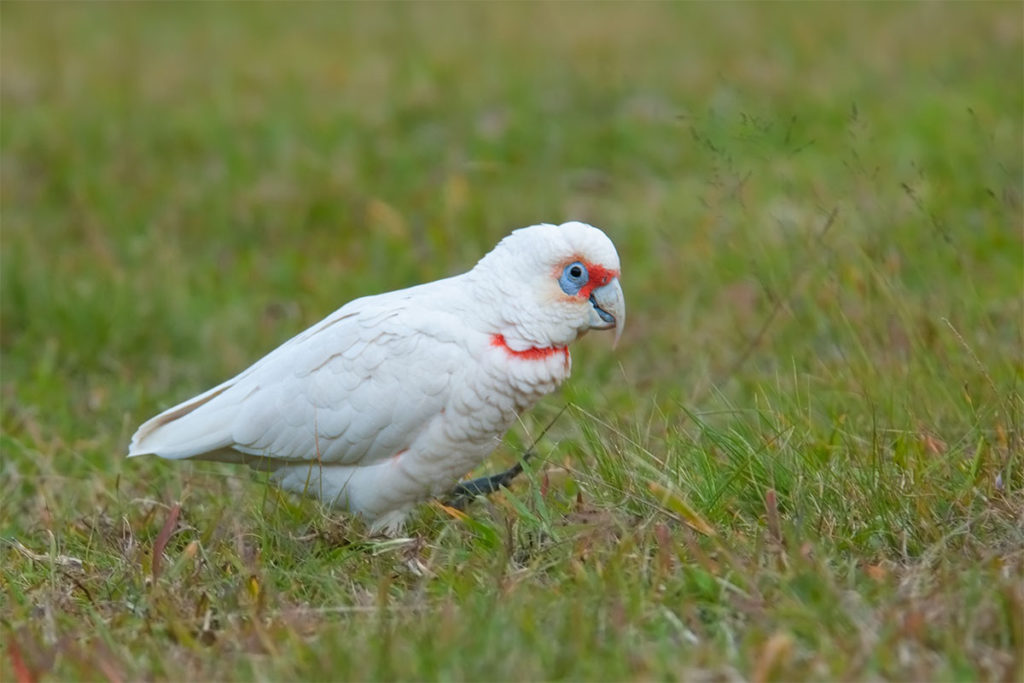
- Latin name: Cacatua tenuirostris
- Conservation Status: Least Concern
The two species of Long-billed corellas have only recently been separated into distinct species: Long-billed corellas in Eastern Australia and Western corella in the west. The eastern Long-billed corella has all-white plumage with bright red-orange splashes on its face and throat and a distinct pale blue eye-ring.
These conspicuous birds occur in southeastern Australia, where they prefer grassy habitats, including city parks. Historically, their habitat did not extend to Sydney, but with continuous habitat alteration, the birds’ distribution range is changing, and they can now often be seen in Sydney suburbs. The good places to see both species of Corellas are the campgrounds in Royal National Park, Kur-rin-gai Chase, and the Blue Mountains, like the Euroka clearing.
Western corella
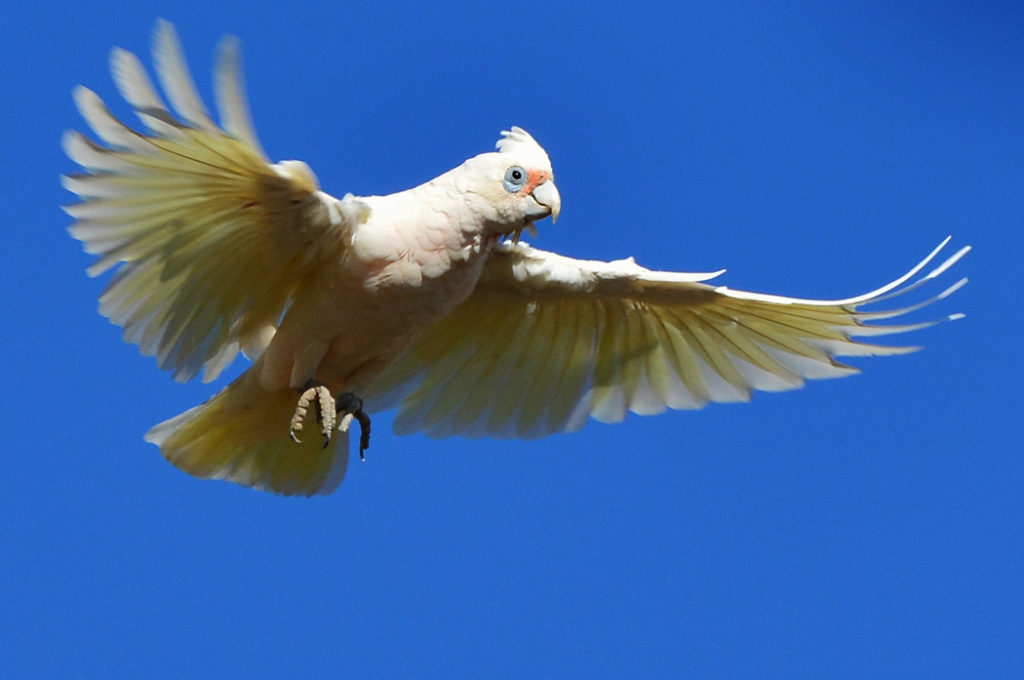
- Latin name: Cacatua pastinator
- Conservation Status: Least Concern
The Western long-billed corella is very similar in appearance to its eastern cousin. They are quite common across southwestern Australia, where they often congregate in huge flocks during the summer months as they move in search of food and water. And because they are gregarious social birds, they are often heard from great distances away.
Little corella
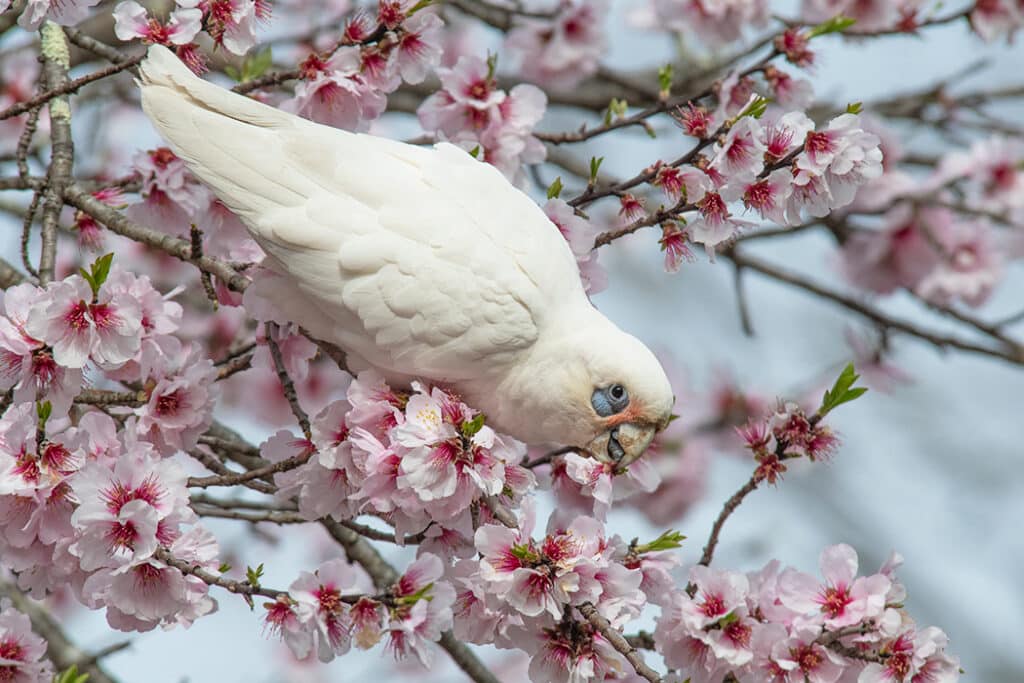
- Latin name: Cacatua sanguinea
- Conservation Status: Least Concern
Similar in appearance to the two species of Long-billed corellas, Little corella is the smallest of the three. Its bill is proportional, and it doesn’t have a red throat.
The most interesting thing about Little corellas is that they like to play. I watched them slide down the roof of a rain tank at Old Andado, only to fly back to the top and slide again. Birdlife Australia reported them riding on the blades of windmills, “spinning round and around, falling off and then regaining a precarious grip on the blades”.
I’m some years, they congregate in Sydney in large flocks, demolishing seed pods of urban trees and depositing a crunchy carpet of twigs and pods on pedestrian walkways. They are particularly conspicuous when they quarrel with Sulphur-crested cockatoos who are even more at home in the city.
Galah
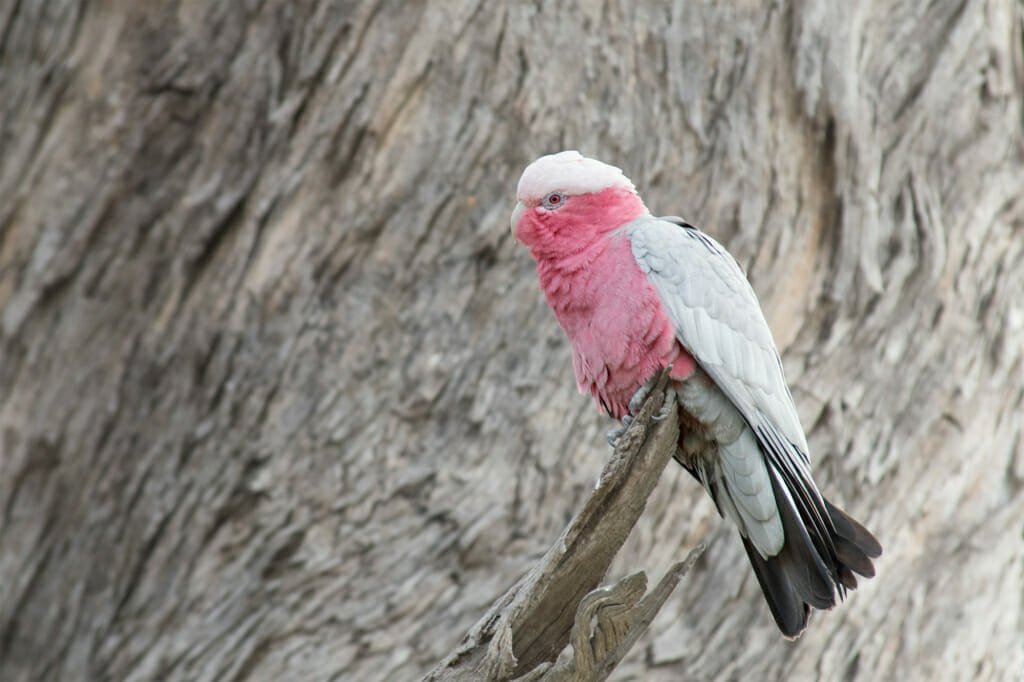
- Latin name: Eolophus roseicapilla
- Conservation Status: Least Concern
Galah is a more reserved and gentle bird than most Australian cockatoos. It has lovely and subtle plumage of light grey back, wings, and tail, pink face, chest, belly and white crown and a light pink crest. It is one of the most common cockatoos throughout Australia.
They usually move in small groups but can congregate in massive flocks of up to a thousand individuals. These flocks can be a mix of different species like Little corellas, Major Mitchell and Sulphur-created cockatoos. In Sydney, they are commonly seen in parks and suburbia.
Major Mitchell’s cockatoo
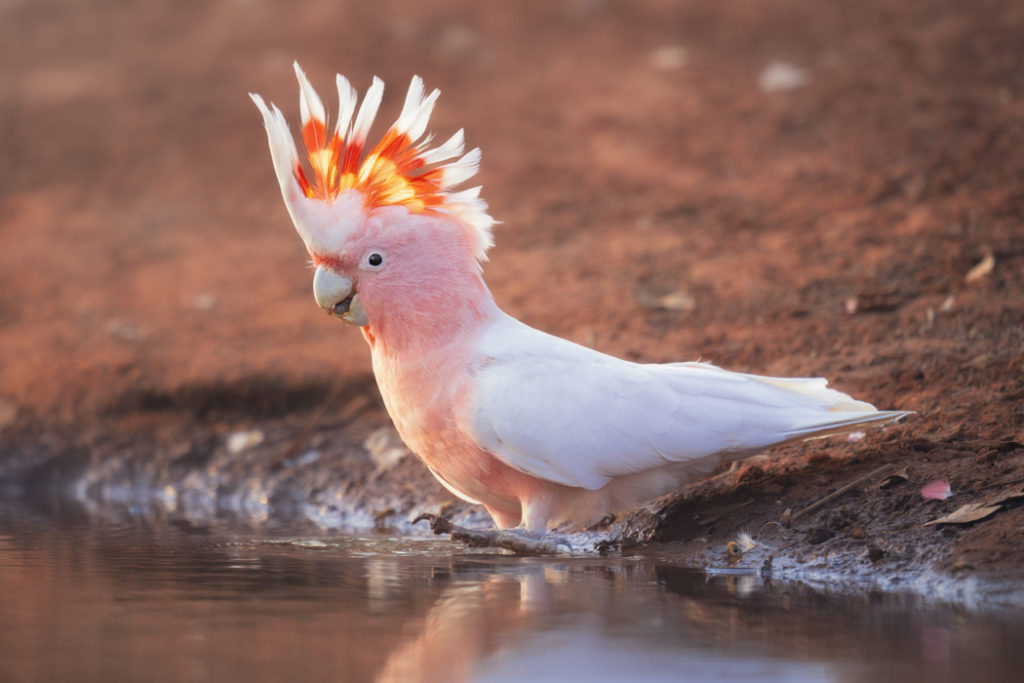
- Latin name: Lophochroa leadbeateri
- Conservation Status: Least Concern
Major Mitchel cockatoo is one of the most handsome Australian cockatoos. It resembles a Sulfur-crested cockatoo but has a salmon pink face, throat, chest and belly. Its most distinctive feature is its magnificent crest with bold red and yellow stripes.
It inhabits arid and semi-arid regions of Australia, where it is quite widespread. I have seen them throughout NSW Outback, in Bowra Sanctuary in Qld, and in Flinders Ranges, South Australia.
Australian Parrots
The rest of the Australian parrots belong to the family of True parrots. These are mostly vividly colourful birds that evolved to exploit almost every type of habitat, from alpine forests and tropical rainforests to beaches and deserts.
Australian true parrots range in size from the large but slender Australian King-parrot and the heavy-set Eclectus parrot to the tiny Double-eyed Fig-Parrot and Little Lorikeet. Most of these species feed on nectar, seeds and insect larvae.
Rainbow Lorikeet
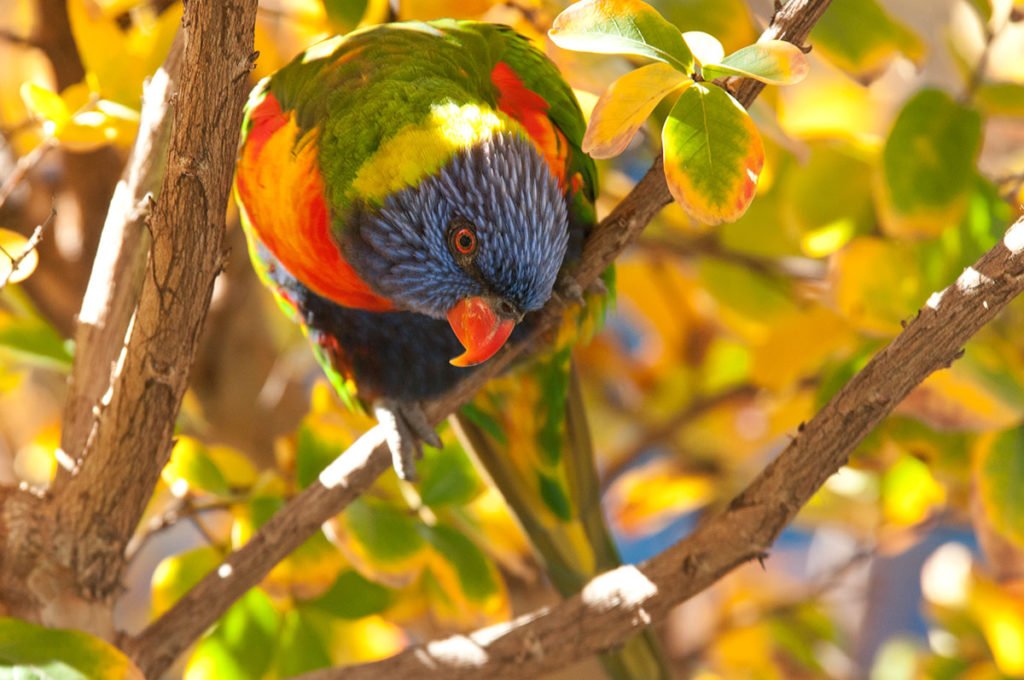
- Latin name: Trichoglossus moluccanus
- Conservation Status: Least Concern
A bright and conspicuous lorikeet that adapted well to the urban development. It is a common species along the eastern seaboard from northern Queensland to South Australia. While its preferred habitat is forest and woodland, it’s quite at home in most cities across its range.
Rainbow lorikeets travel in small flocks as they feed on pollen as well as some fruits, seeds and insects. They are quite brazen birds and tend to outcompete other parrot species in urban environments. In Sydney, Rainbow lorikeets are found anywhere where there are flowering plants.
Red-collared Lorikeet
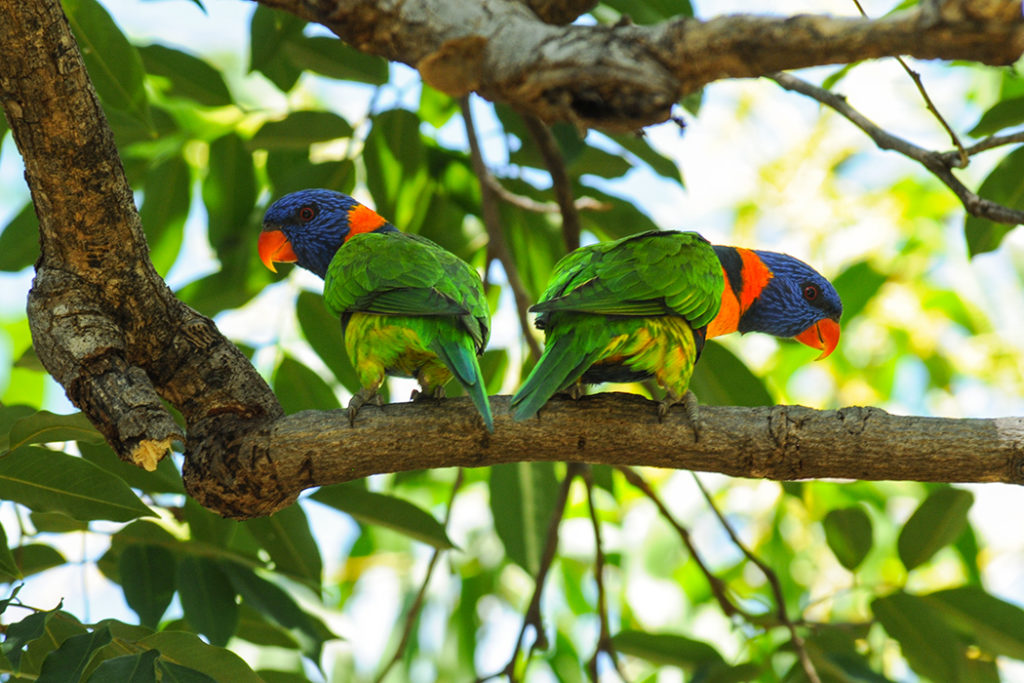
- Latin name: Trichoglossus rubritorquis
- Conservation Status: Least Concern
Very similar in appearance to the Rainbow lorikeet, the Red-collared Lorikeet is distinguished by a red band on the back of its neck. This species occurs in Northern Australia, where they prefer forested habitats but also seem quite comfortable in the cities. Like Rainbow lorikeets, these are conspicuous birds that move about in pairs or small flocks, chirping loudly and consistently.
Surprisingly, I only encountered them a few times on our road trip across the Northern Territory: in Katharine Gorge and in Darwin Botanic Gardens.
Scaly-breasted Lorikeet
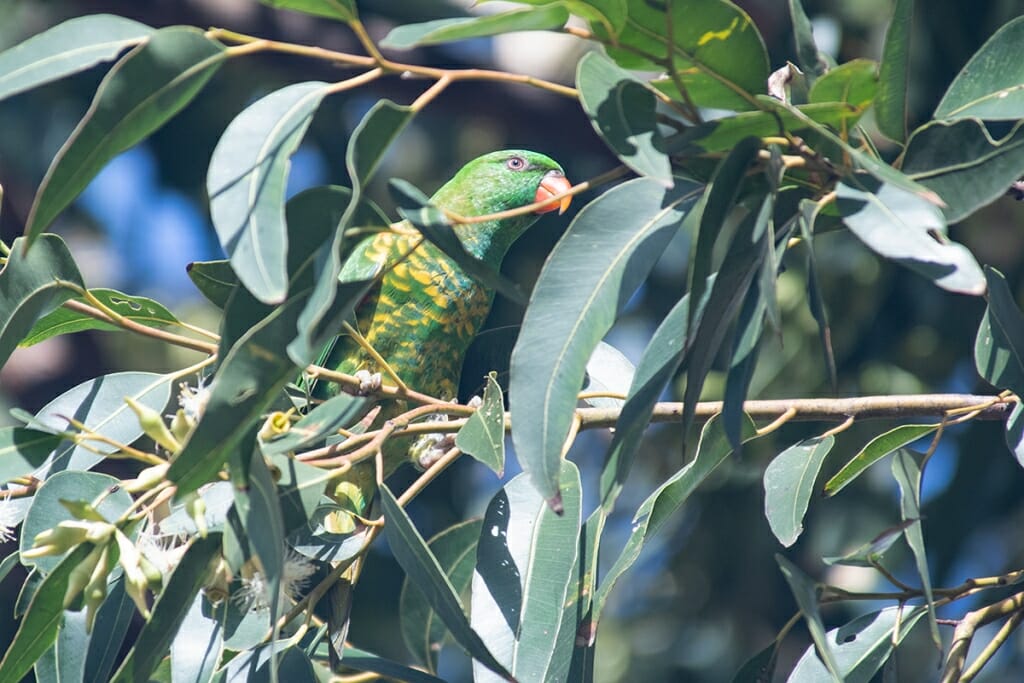
- Latin name: Trichoglossus chlorolepidotus
- Conservation Status: Least Concern
This species has a yellow chest and belly edged with green, which gives them a scaly appearance. They are common in forested habitats along the eastern coast of Australia. Feeding high up in the canopy, they can often be missed in areas where rainbow lorikeets are abundant. Plus, their mostly green plumage provides excellent camouflage among the green leaves.
Scaly-breasted lorikeets move about in small noisy flocks, so you are more likely to hear them than see them. The only time I had a good look at them was when I came across a dock feeding on a flowering tree in Anna Bay in Port Stephens, NSW.
Varied Lorikeet
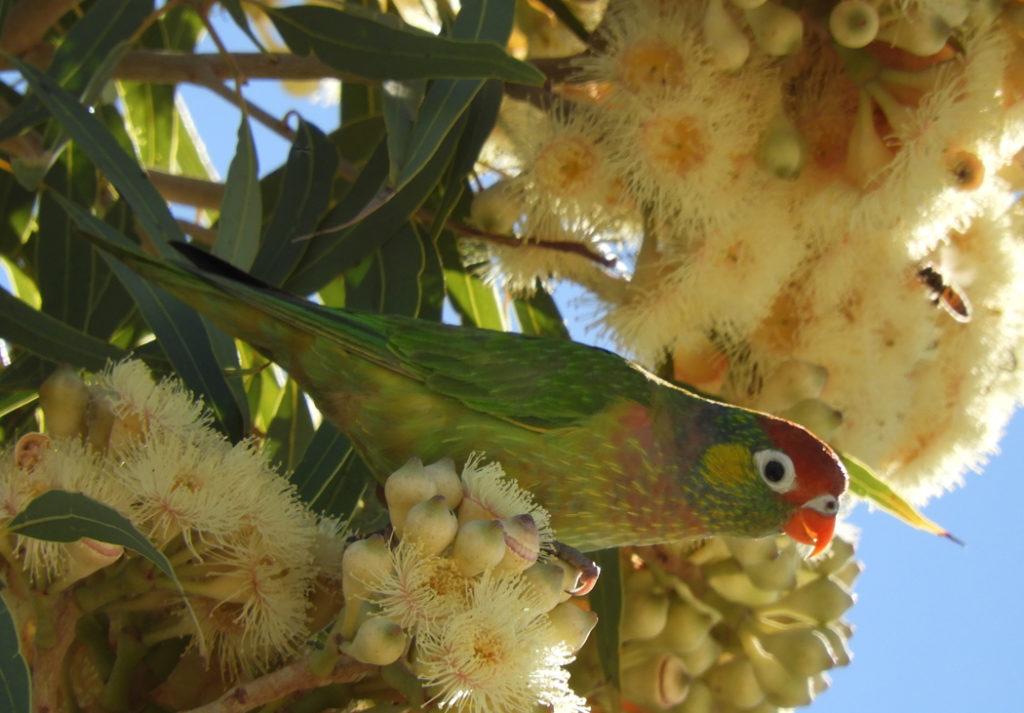
- Latin name: Psitteuteles versicolor
- Conservation Status: Least Concern
Varied lorikeet has mostly green plumage with yellow streaks and a conspicuous red crown. It inhabits tropical forests and grasslands in northern Australia, from northern Queensland to the Northern Territory and Western Australia, where they lead a nomadic lifestyle following the flowering season of their favourite trees.
They travel in large flocks and can be aggressive towards other species feeding nearby. This species is quite common in the western part of its range but becoming rarer in the eastern part.
Musk Lorikeet
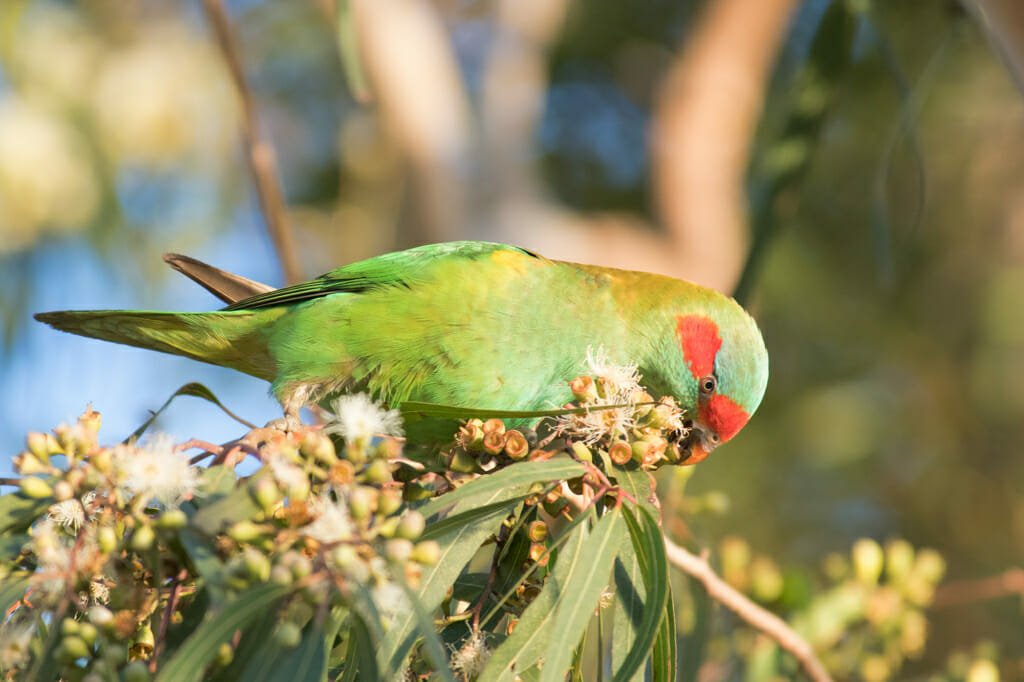
- Latin name: Glossopsitta concinna
- Conservation Status: Least Concern
A mostly green lorikeet with conspicuous red patches across the forehead and ears. It is common throughout southeastern Australia, where it prefers dry forests and woodlands, but also often found in the city parks.
Musk lorikeets can congregate in large flocks, often mixing with Rainbow lorikeets, especially in the crowns of flowering eucalypt trees. A good spot to watch them is Mt Annan Botanic garden in Sydney, where they nest in the hollows of large trees growing just past the entrance to the gardens.
Little Lorikeet
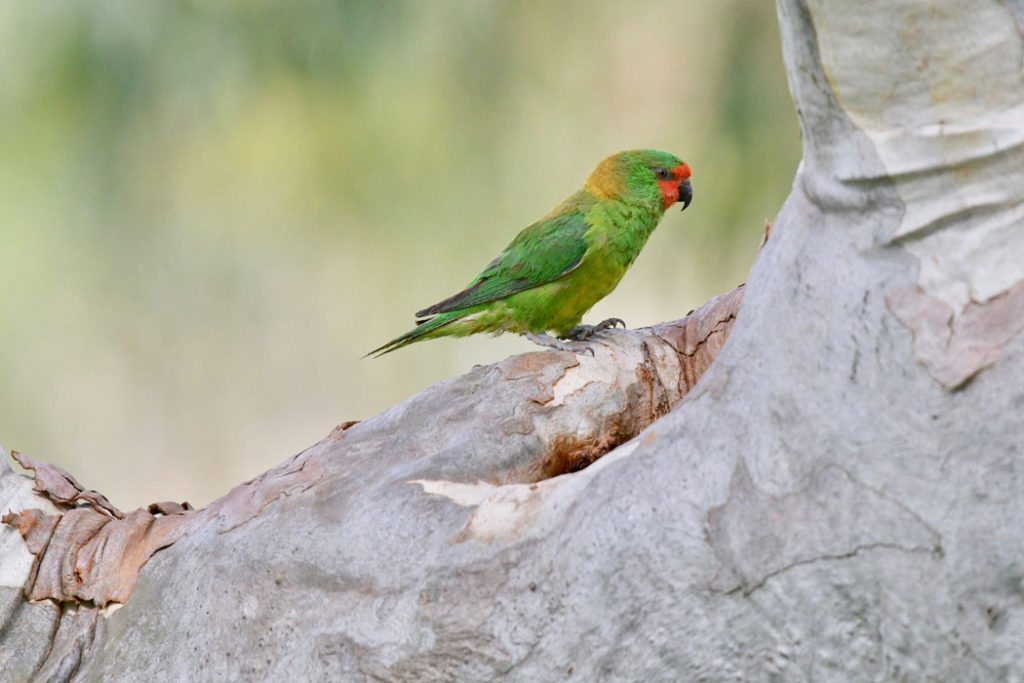
- Latin name: Parvipsitta pusilla
- Conservation Status: Least Concern
Little lorikeet is one of the smallest Australian parrots, growing to all of 15 centimetres in length. It has mostly green plumage and a red face. A forest-dwelling species, it is found in southern and eastern Australia.
Its small size makes Little lorikeet hard to see among the green leaves that can be as big as the bird itself. They move about in small flocks, congregating in higher numbers in the flowering trees. The only time I saw them was when another birder pointed them out to me, feeding noisily in the crown of a tall eucalypt tree in Mt Annan Botanic Gardens in Sydney.
Purple-crowned Lorikeet
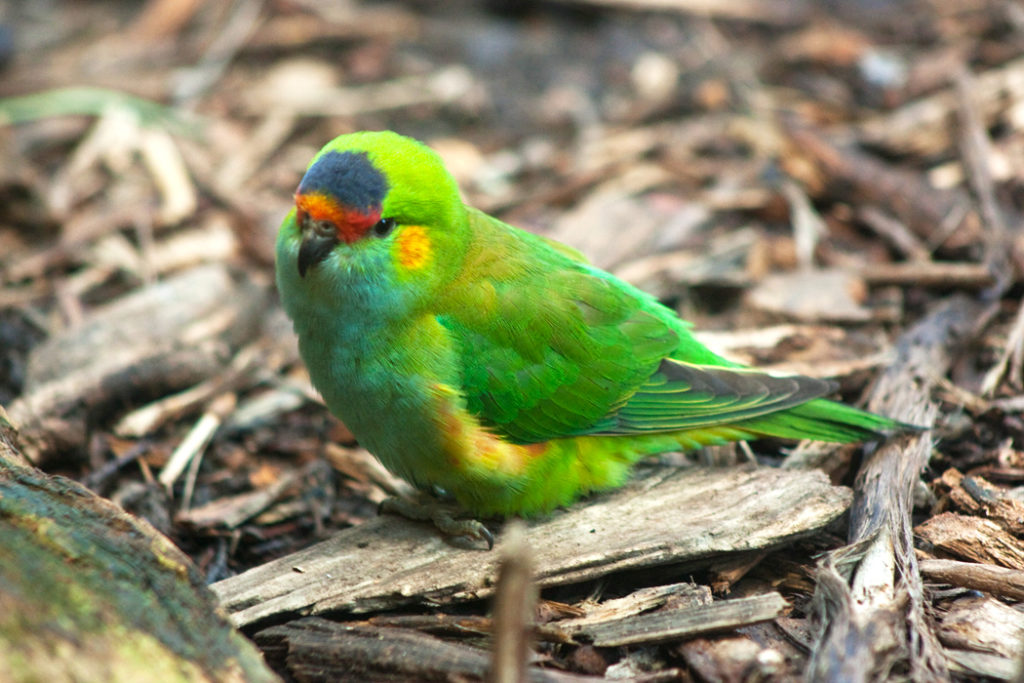
- Latin name: Parvipsitta porphyrocephala
- Conservation Status: Least Concern
A small lorikeet with mostly green plumage distinguished by a dark purple crown, a yellow-orange forehead and ear-coverts, and a light blue chin, chest and belly. It is found in southwest Western Australia and southern South Australia, including Kangaroo Island.
Like many other lorikeet species, Purple-crowned lorikeets are blossom nomads. They follow the flowering season of their favourite trees, moving about in small flocks. However, once they find a rich source of nectar, they often congregate in mixed flocks with rainbow and musk lorikeets.
Double-eyed Fig-Parrot
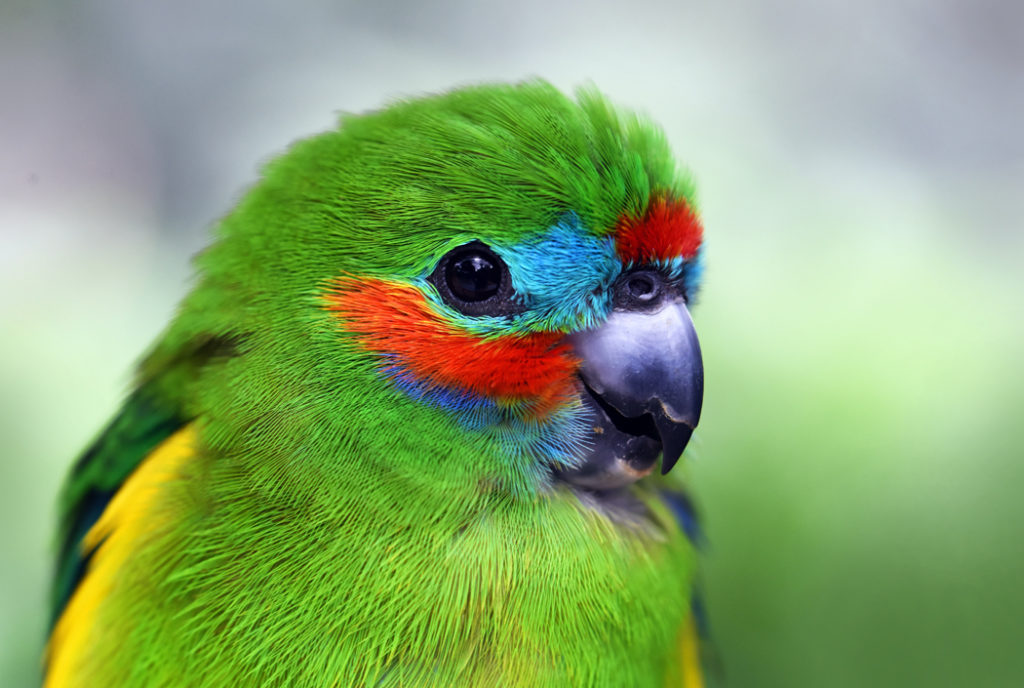
- Latin name: Cyclopsitta diophthalma
- Conservation Status: Least Concern
Growing to just 14 centimetres in length, the Double-eyed fig parrot is the smallest Australian parrot. It has a very handsome face with turquoise eye patches, red cheeks and a red spot on its forehead. It occurs primarily in New Guinea but has also made its way to Far North Queensland and northern NSW, around Richmond River.
While the species is listed as Least Concern, the NSW subspecies, Coxen’s fig parrot, is Critically Endangered in the state. Fig parrots travel in pairs or small flocks as they search for figs, berries, seeds, nectar and insect larvae.
Eclectus Parrot
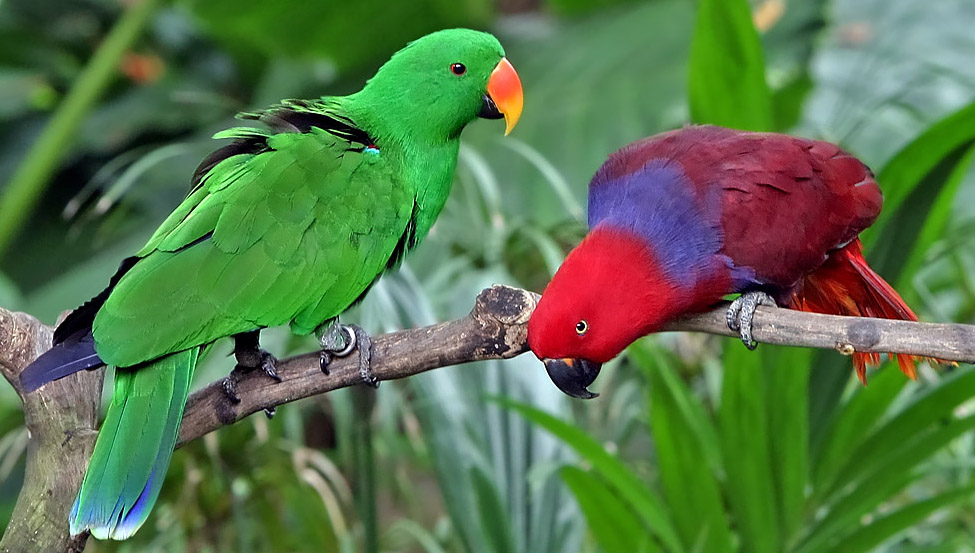
- Latin name: Eclectus roratus
- Conservation Status: Least Concern
The male and female Eclectus parrots look as different, as if they belong to different species. The male is emerald green, while the female is vivid red. They are noisy and conspicuous birds calling and screeching loudly when they fly or feed on the rainforest canopy.
In Australia, Eclectus parrots occur in the northeastern region, where they live in the rainforest and adjacent eucalypt woodland.
Red-cheeked Parrot
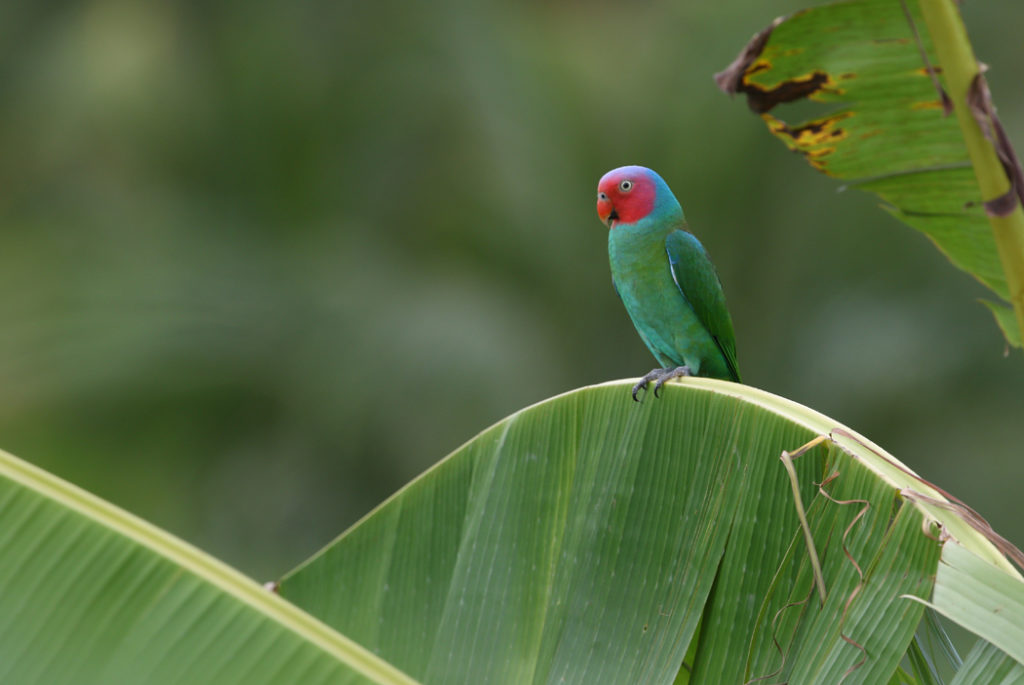
- Latin name: Geoffroyus geoffroyi
- Conservation Status: Least Concern
Red-cheeked parrot is a handsome parrot occurring on the Cape York Peninsula. It prefers subtropical and tropical dry forests, moist lowland forests and mangroves. These birds usually live in pairs or small family groups. However, they can gather in noisy, conspicuous groups when feeding on figs, seeds, blossoms and nectar. These parrots are rarely found on the ground – they are not great walkers.
Australian King-Parrot
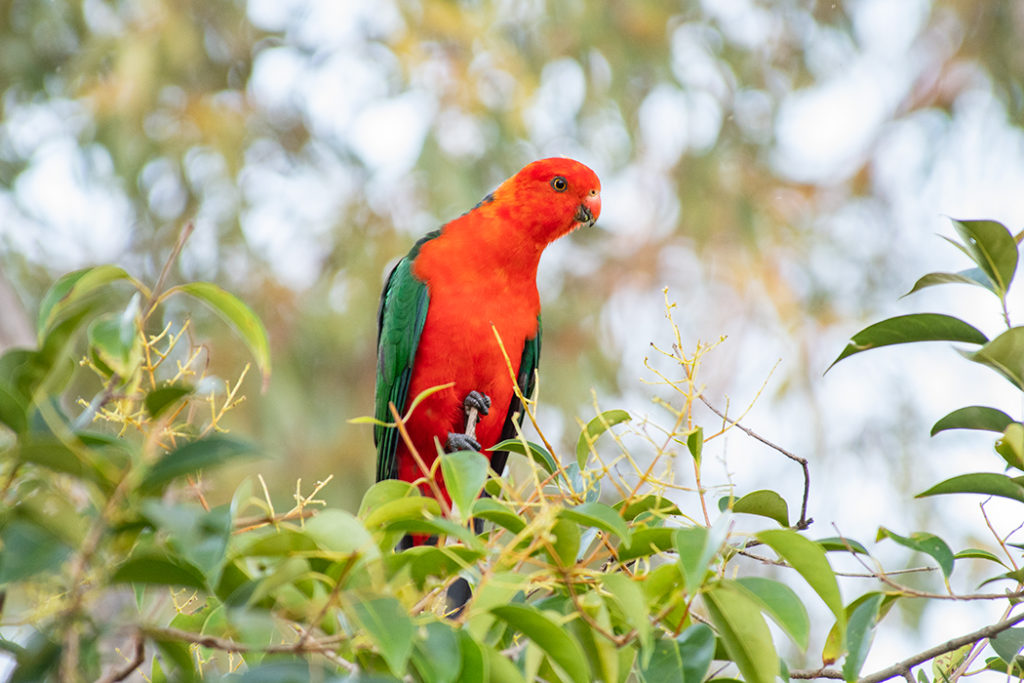
- Latin name: Alisterus scapularis
- Conservation Status: Least Concern
The largest Australian true parrot, the King parrot, is endemic to the coast and mountain ranges of eastern Australia, from Cooktown in Queensland to Port Campbell in Victoria. It prefers rainforests and wet sclerophyll forests, where it forages on seeds and fruit.
Around Sydney, a good place to see King parrots is Dangar Island on the Hawkesbury River, in Kangaroo Valley or at Green Patch in Jervis Bay. Further inland, Warrumbungles NP is a good spot.
Red-winged Parrot
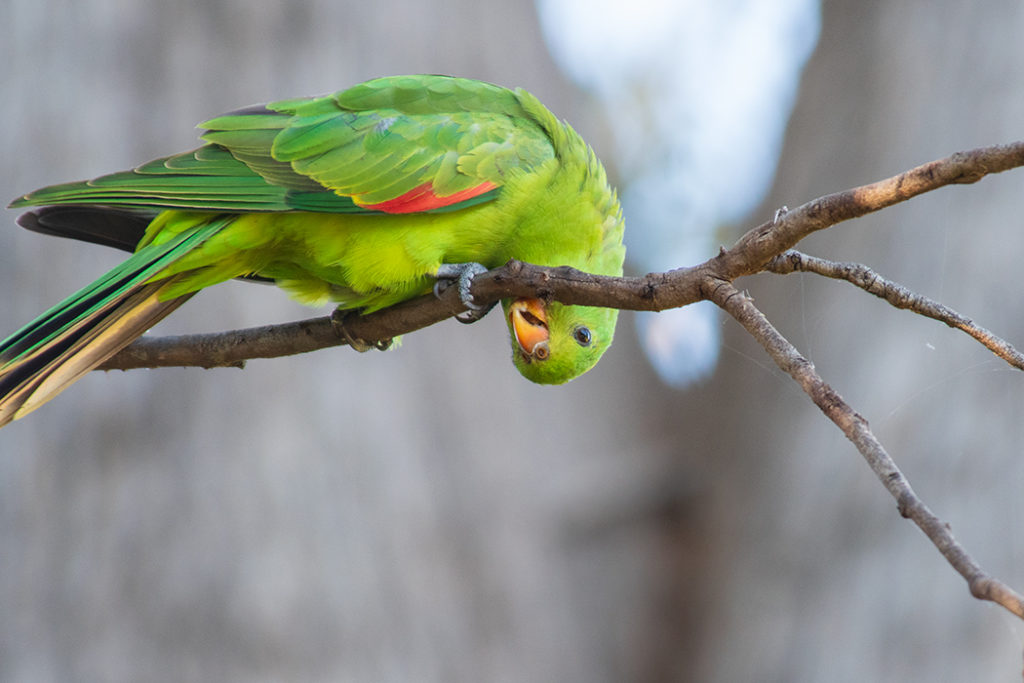
- Latin name: Aprosmictus erythropterus
- Conservation Status: Least Concern
Red-winged parrot is widespread in northern and eastern Australia. It prefers open habitats like dry woodlands, forested riverbanks, grasslands, and scrubland. These parrots live in pairs or small flocks. They feed on seeds, berries, blossoms and nectar, usually high in the canopy.
They are a common site in the Northern Territory, including Katherine Gorge and Kakadu National Park. In NSW, Warrumbungle National Park is a good place to see them.
Superb Parrot
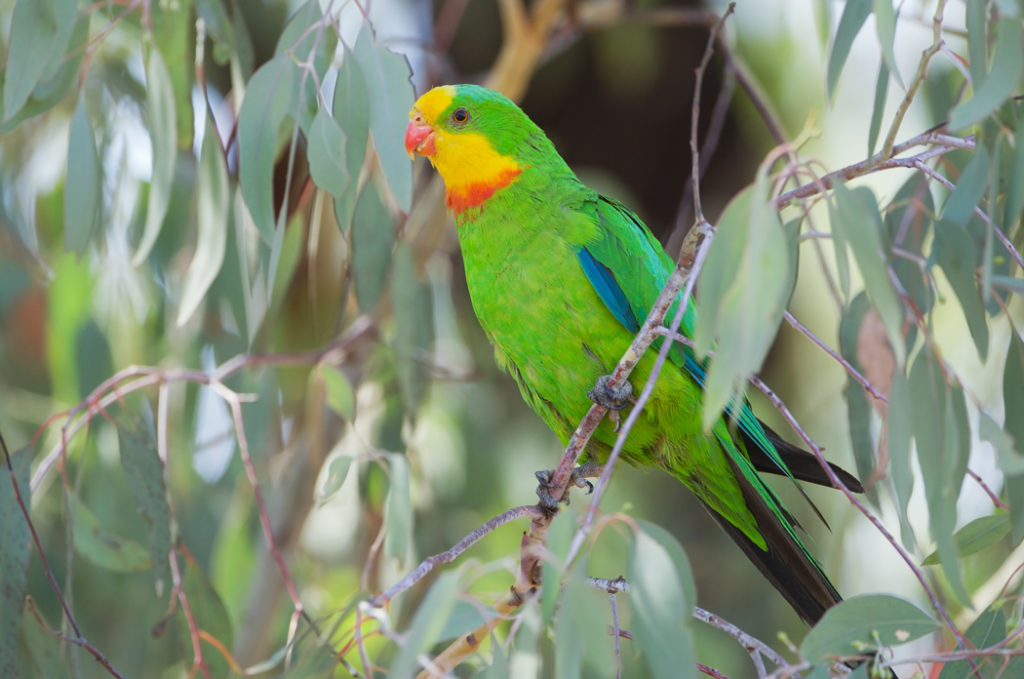
- Latin name: Polytelis swainsonii
- Conservation Status: Least Concern
The Superb parrot is endemic to southeastern Australia. It is found in the Riverina area of New South Wales and Victoria and, in winter, in northern New South Wales. It is unusual among parrots in that it daily moves between its nesting areas among river red gums along inland rivers and its feeding areas in the adjacent riverine plains. As they fly between their breeding and feeding areas each day, they sometimes gather in large flocks of 30 birds or more.
A good place to look for them is along the Murrumbidgee River from Wagga Wagga west to Carrathool. The majority of their known nesting sites are located in the river red gums of the Murrumbidgee Valley National Park.
Regent Parrot
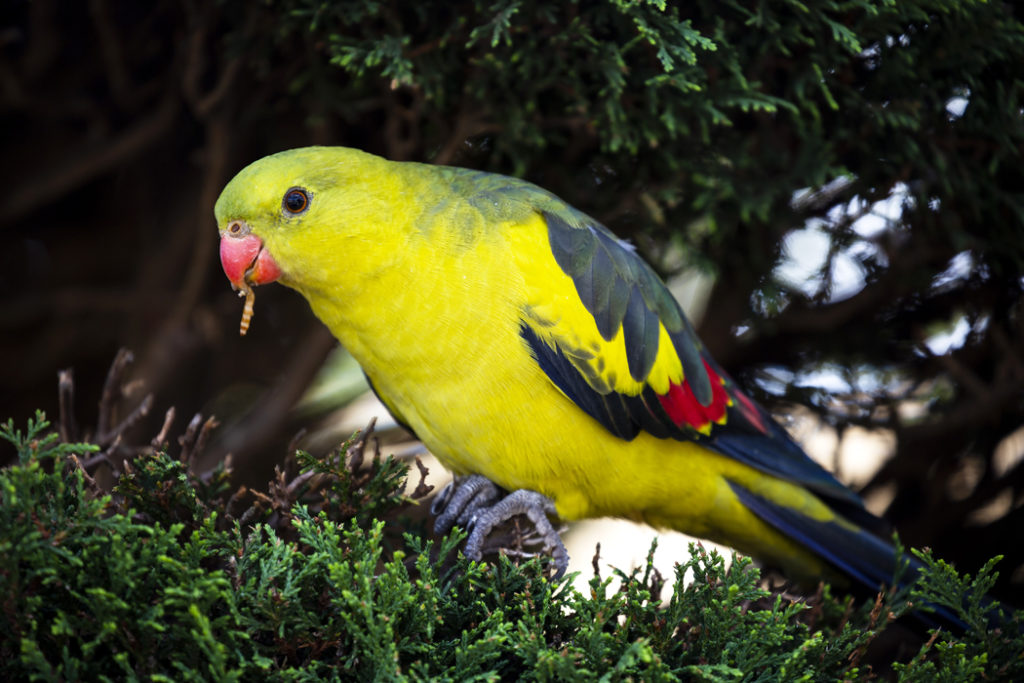
- Latin name: Polytelis anthopeplus
- Conservation Status: Least Concern
There are two populations of the Regent parrot in Australia. One southwestern New South Wales, north-western Victoria and the Murray Mallee region of South Australia, and another in southwest Western Australia.
Regent parrots move about in pairs or congregate in flocks of 20 or so birds. They forage mostly on the ground, feeding on grass seeds.
Princess Parrot
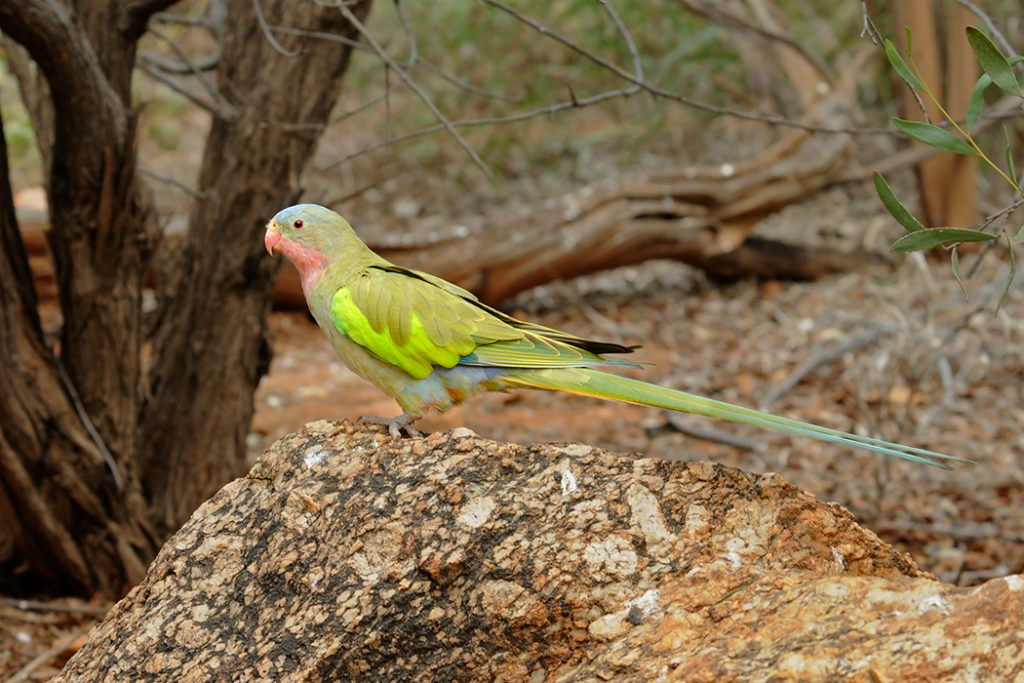
- Latin name: Polytelis alexandrae
- Conservation Status: Near Threatened
Princess parrot is a desert species widely distributed across inland regions of Western Australia, the Northern Territory and South Australia. This elusive nomadic species is one of Australia’s least known parrots. What is known about them is that, unlike most parrots, they engage in mobbing behaviour against predators.
Green Rosella
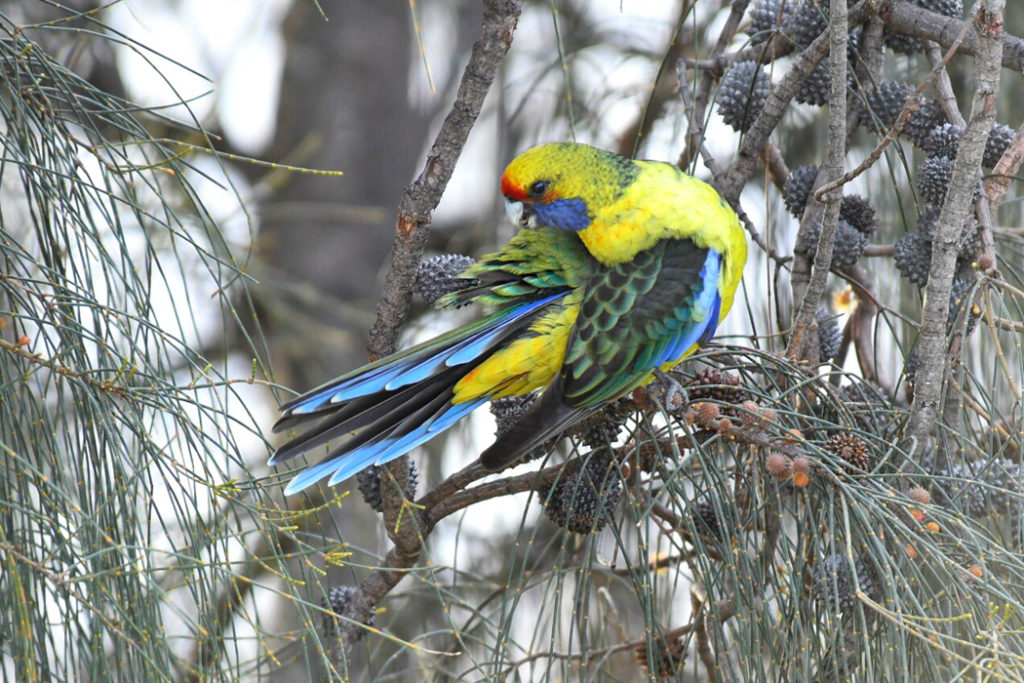
- Latin name: Platycercus caledonicus
- Conservation Status: Least Concern
Tasmania’s only endemic species, Green rosella, is the largest rosella species in Australia. It can be found across Tasmania in any wooded habitat type where it feeds on grass seeds, fruits, berries, nectar and insect larvae.
Bruny Island and Cradle Mountain are good places to see Green rosellas. In the mountains, they can even be spotted in winter when the landscape is covered by a blanket of snow.
Crimson Rosella
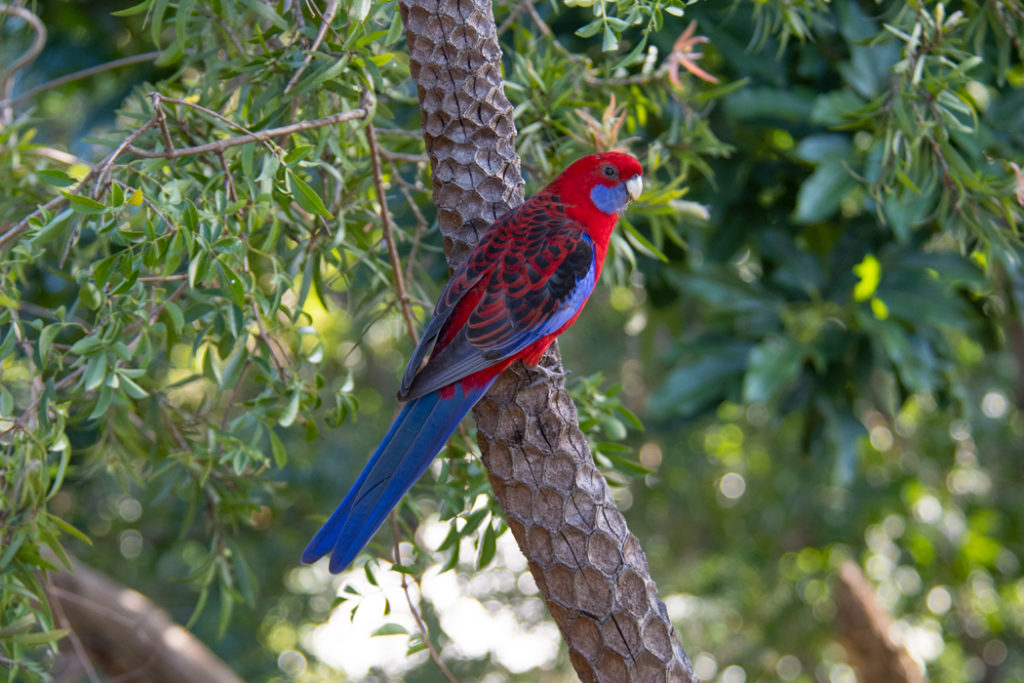
- Latin name: Platycercus elegans
- Conservation Status: Least Concern
The most vibrant rosella, Crimson rosella, is actually not always crimson. In NSW outback, along the Murray River, crimson rosellas are yellow, black and blue, and in South Australia, they are intermediate between crimson and yellow.
Overall the species is broadly distributed across southeastern Australia. The crimson birds can be found from northern Queensland to South Australia, including Kangaroo Island. They can often be seen in and around Sydney, particularly in Royal National Park. Kangaroo Valley is another good place to see them, particularly at the Cambewara Mountain lookout.
Orange birds can be spotted in Flinders Rangers and the yellow birds along the Murray and Murrumbidgee rivers. This species often feed on the ground, foraging on grass seeds, which makes them quite easy to see.
Eastern Rosella
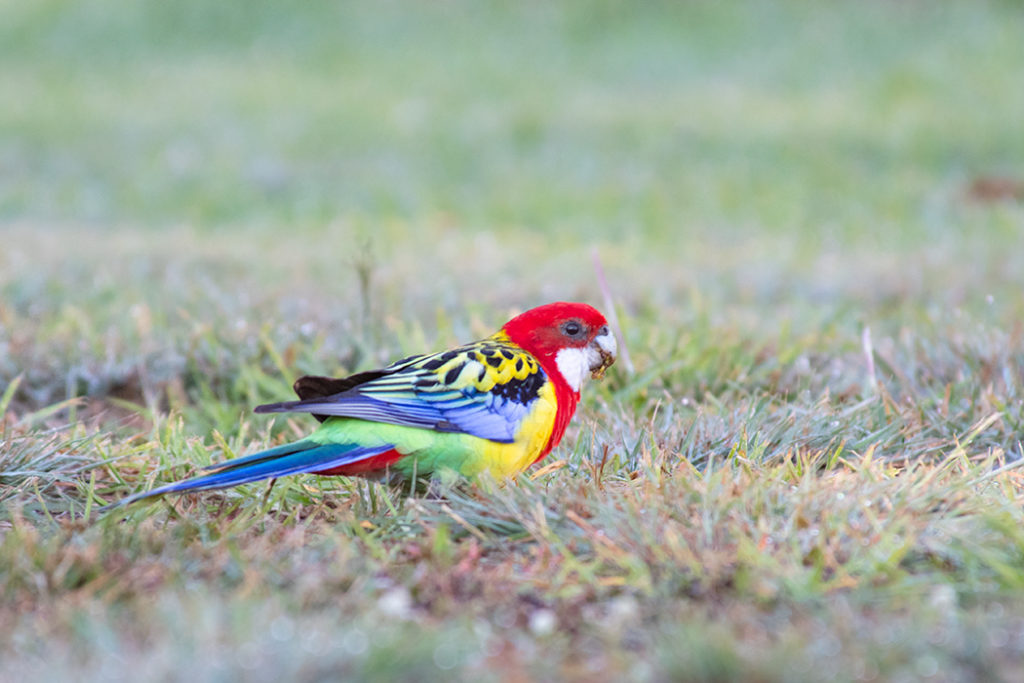
- Latin name: Platycercus eximius
- Conservation Status: Least Concern
Eastern rosella is native to eastern Australia, including Tasmania. It is found in open woodlands, grasslands, farmlands and urban parks, where it mainly feeds on the ground. These handsome birds mate for life and usually travel in pairs.
They are frequently seen in Sydney parks, including Centennial park in the city centre to Mount Annan Botanic Gardens in the west.
Pale-headed Rosella
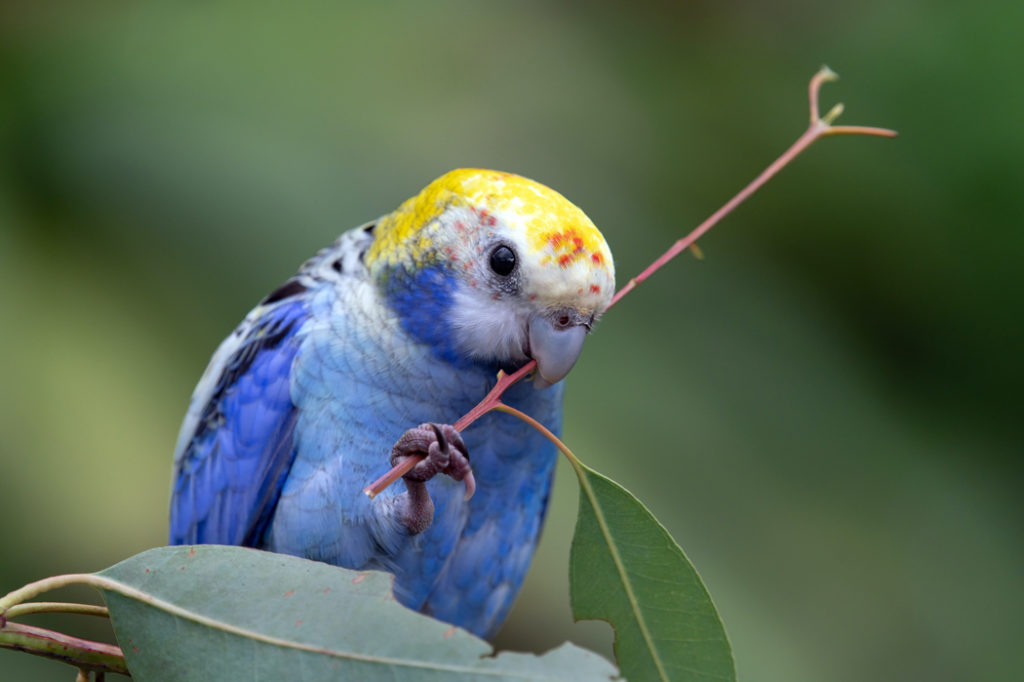
- Latin name: Platycercus adscitus
- Conservation Status: Least Concern
Pale-headed rosella occurs mostly in Queensland from the Cape York Peninsula to Cardwell in central-northern Queensland and has quite a varied colouration across its range.
Despite their bright plumage, Pale-headed rosellas blend surprisingly well with the green leaves and can be quite tricky to spot. They prefer savanna woodlands and woodlands with a grassy understorey, where they feed mostly on the ground.
Northern Rosella
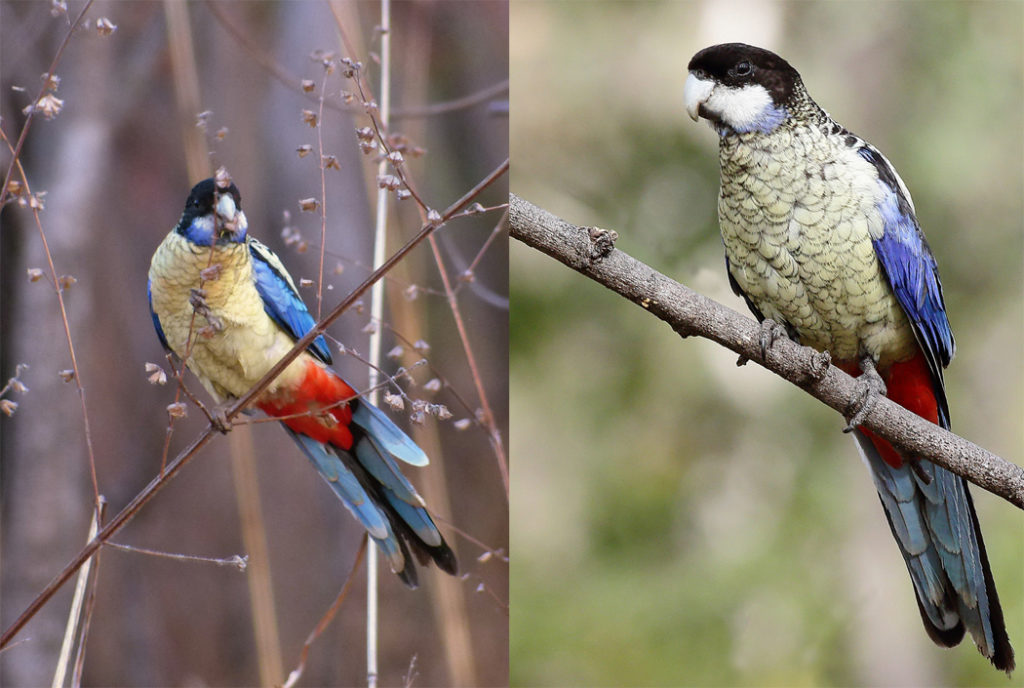
- Latin name: Platycercus venustus
- Conservation Status: Least Concern
As its name suggests, Northern rosella is found in northern Australia. It is quite a shy and elusive rosella that flees rapidly when disturbed. It lives in grassy open forests, woodlands, and savannas, where it feeds on grass seeds, eucalypt seeds, flowers and berries.
Western Rosella
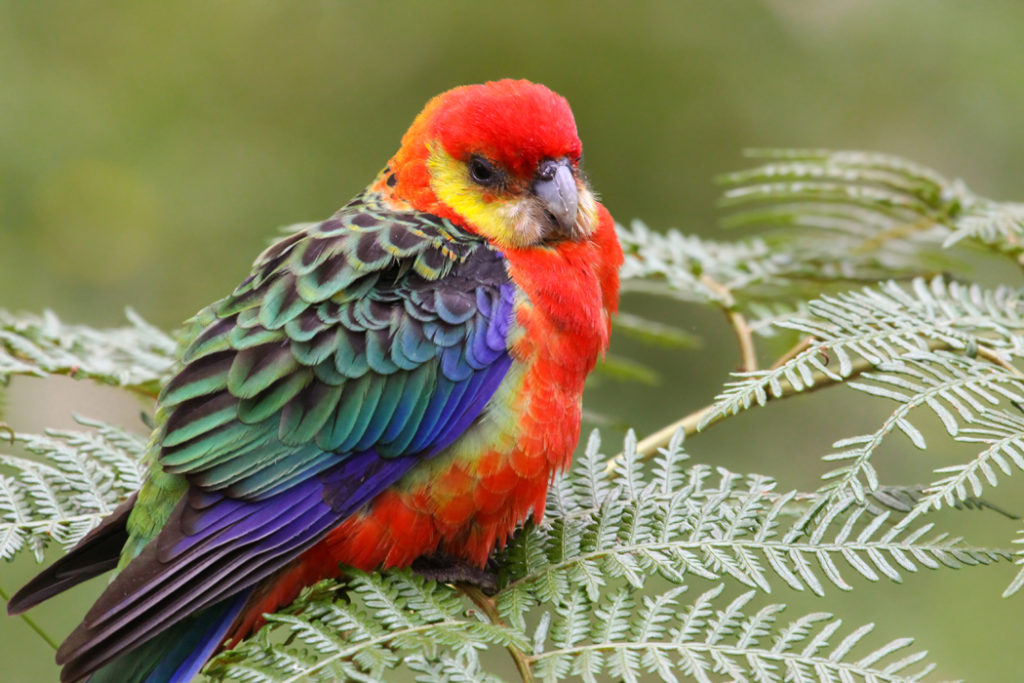
- Latin name: Platycercus icterotis
- Conservation Status: Least Concern
The smallest rosella species, Western rosella, is restricted to the southwestern corner of Australia. Like all other rosellas, it feeds mostly on the ground, browsing on grass seeds, fruits, blooms, and insect larvae.
Western Rosellas are usually in pairs or small family groups, but in winter, they congregate in small flocks.
Australian Ringneck
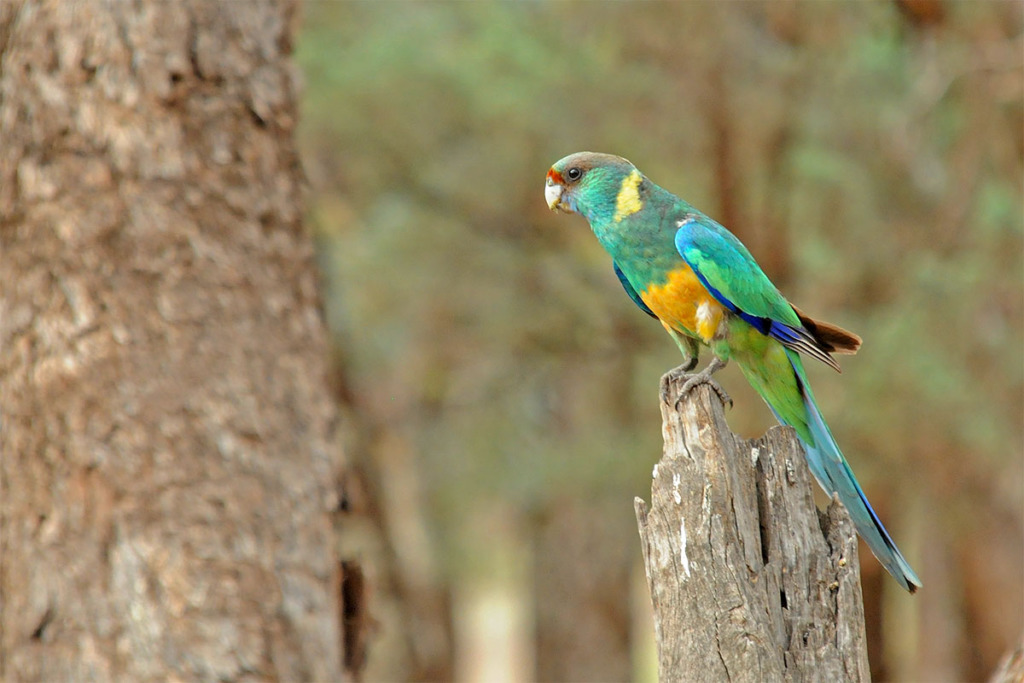
- Latin name: Barnardius zonarius
- Conservation Status: Least Concern
The Australian Ringneck is found throughout the inland regions of Australia, but it is generally absent from coastal areas in the eastern states. It prefers eucalypt woodlands and eucalypt-lined watercourses where it feeds on nectar, seeds and fruit, as well as insects.
Ringnecks are quite abundant throughout the Outback. One of the best places I found to observe them is the Wilpena Pound campground in Flinders Ranges National Park in South Australia.
Red-capped Parrot
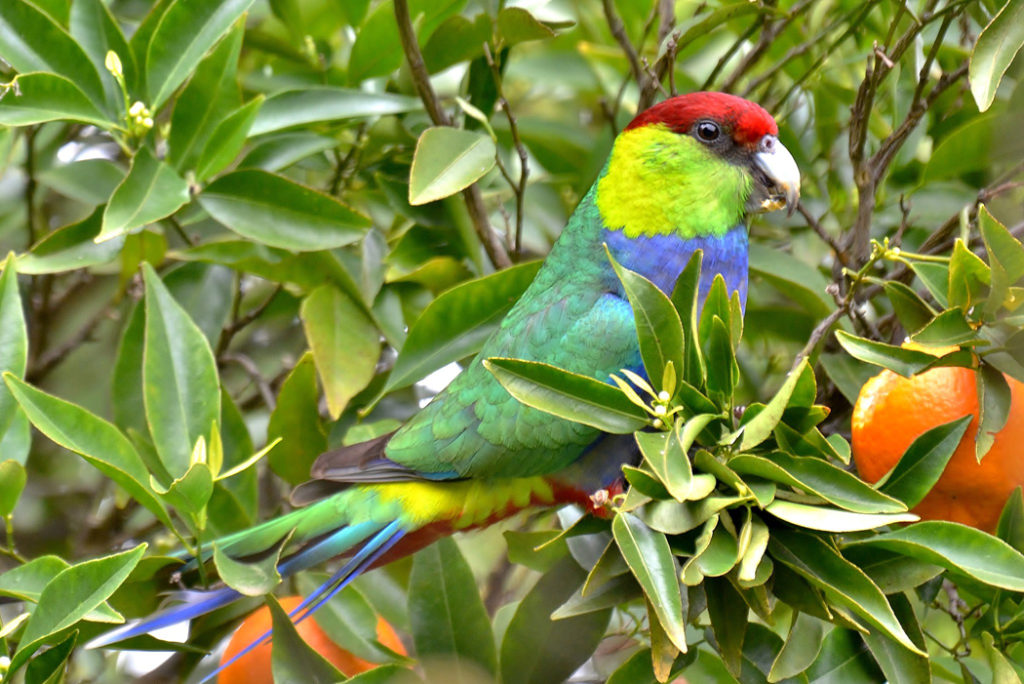
- Latin name: Purpureicephalus spurius
- Conservation Status: Least Concern
Easily identified by its red crown, the Red-capped parrot is endemic to the woodlands, forests, and open savanna of Southwest Australia between Perth to Esperance. It is a sedentary species that feeds primarily on seeds, flowers, berries, and occasionally insects.
Bluebonnet
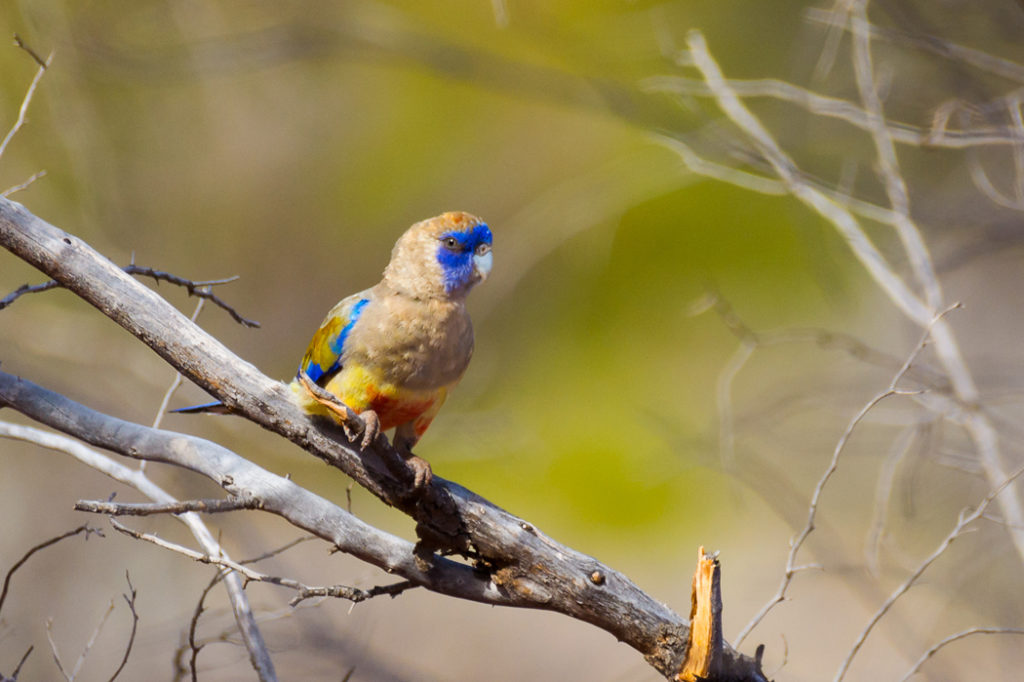
- Latin name: Northiella haematogaster
- Conservation Status: Least Concern
A resident of arid and semi-arid landscapes, Bluebonnet is found from southern Queensland to New South Wales and Victoria and southwestern Western Australia. It lives on open plains and among saltbush or bluebush shrubs, where it feeds on seeds, fruit, nectar and insects.
Blu bonnets usually forage on the ground and move about in pairs or small groups. They can also join mixed flocks with other parrots like the Australian Ringneck and Mulga Parrot.
We saw Bluebonnets briefly in the plains surrounding Warrumbungle National Park in NSW Outback.
Swift Parrot
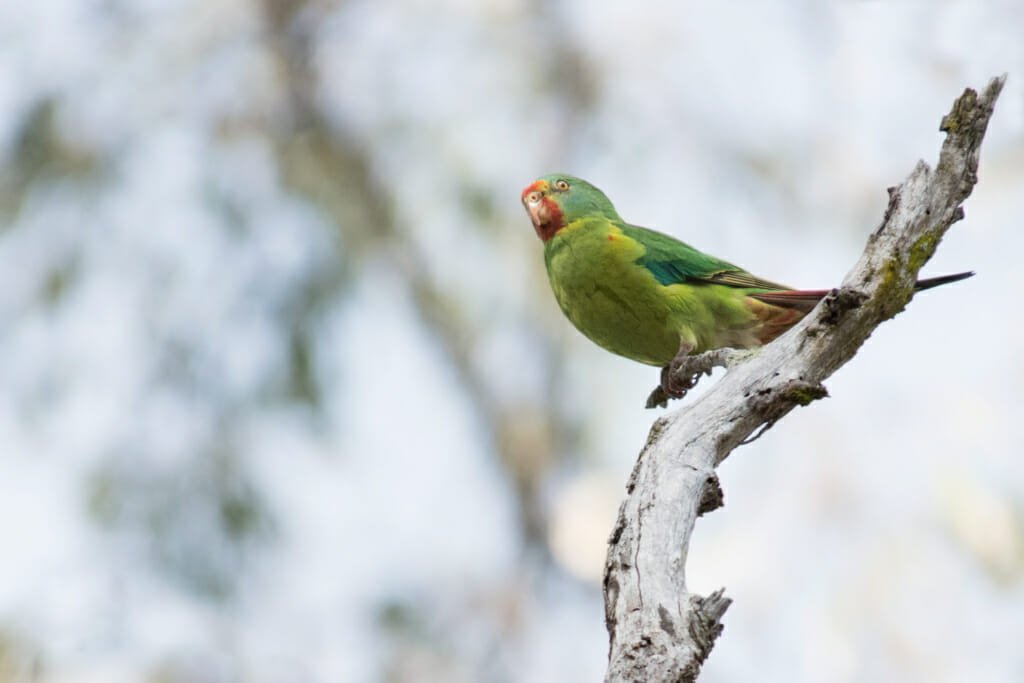
- Latin name: Lathamus discolor
- Conservation Status: Critically Endangered
The Swift parrot is one of the most Endangered parrots in Australia. It is estimated that there are no more than 2000 Swift Parrots left in South-Eastern Australia, making them one of the rarest Australian parrots.
This attractive parrot breeds in Tasmania in summer and migrates to the mainland in winter. Ironically, one of the biggest threats to its survival (apart from habitat loss) is considered to be the predation by one of Australia’s cutest possums – the Sugar Glider.
I was very lucky to see Swift parrots when they visited Mount Annan Botanic Gardens in Sydney.
Red-rumped Parrot
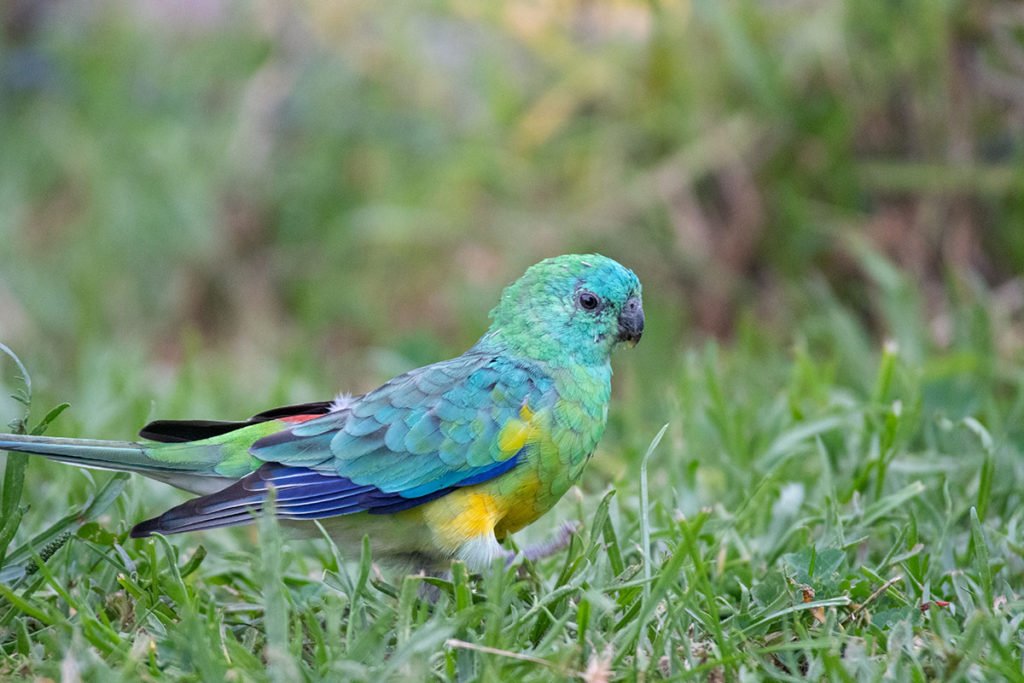
- Latin name: Psephotus haematonotus
- Conservation Status: Least Concerned
The Red-rumped Parrot occurs in southeastern Australia, throughout most of New South Wales and in parts of South Australia and southwestern Queensland.
These handsome parrots mate for life.
They typically forage in pairs or small flocks and can often be spotted in feeding flocks, among the rosellas and galas. A good place to see the Red-rumped parrot in Sydney is Mt Annan Botanic Gardens. They are also often seen at the Sydney Olympic Park.
Mulga Parrot
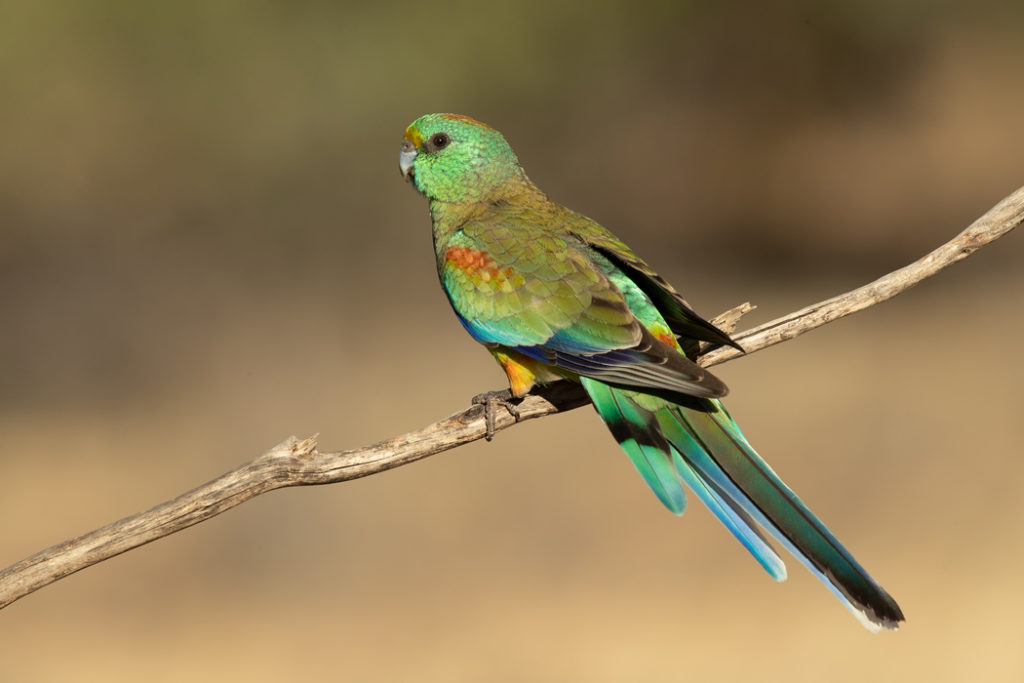
- Latin name: Psephotellus varius
- Conservation Status: Least Concern
The Mulga parrot occurs in arid scrublands and wooded grasslands in the interior of southern Australia, from western New South Wales to central Western Australia.
Like most small Australian parrots, they feed on seeds, flowers, and insect larvae. They move around in pairs or in small family groups.
The only place I’ve seen Mulga parrots was on the Eyre Peninsula during a wildlife survey.
Golden-shouldered Parrot
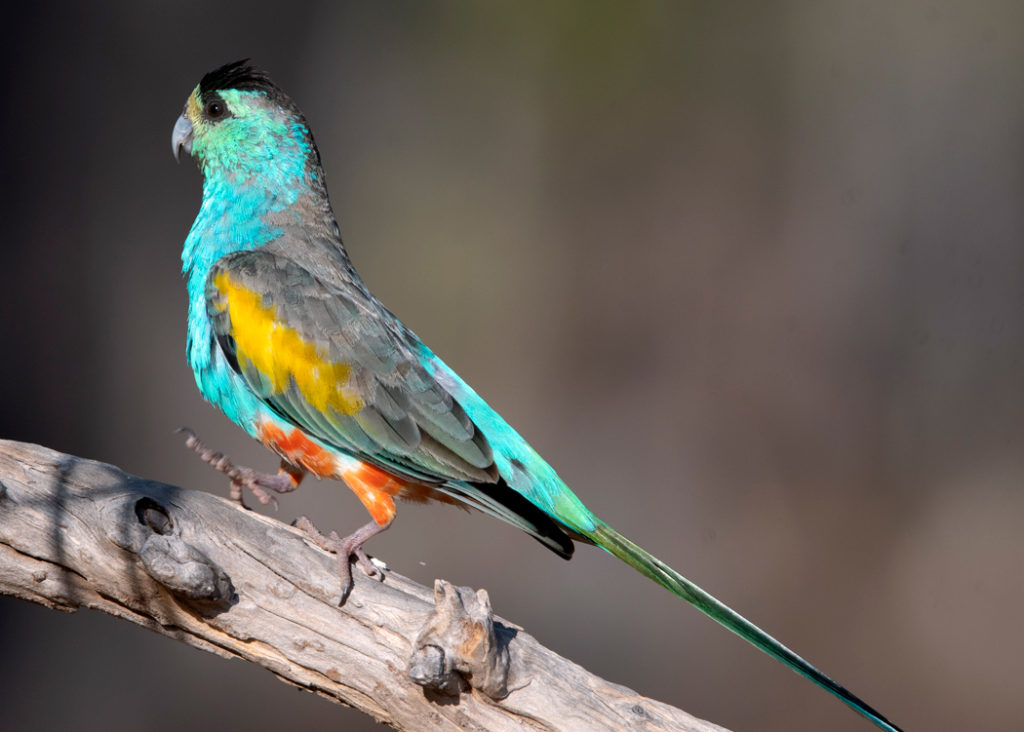
- Latin name: Psephotellus chrysopterygius
- Conservation Status: Endangered
Native to the southern Cape York Peninsula in Queensland, the Golden-shouldered parrot is unique in that it nests in termite mounds. These striking birds build their nests at the end of a tunnel that they dig in the side of a termite mound.
They feed mostly on grass seeds, and for a few months a year, their diet is dependent almost entirely on the seeds of firegrass.
This dependence on termites and firegrass makes the Golden-shouldered parrot very vulnerable to habitat loss.
Hooded Parrot
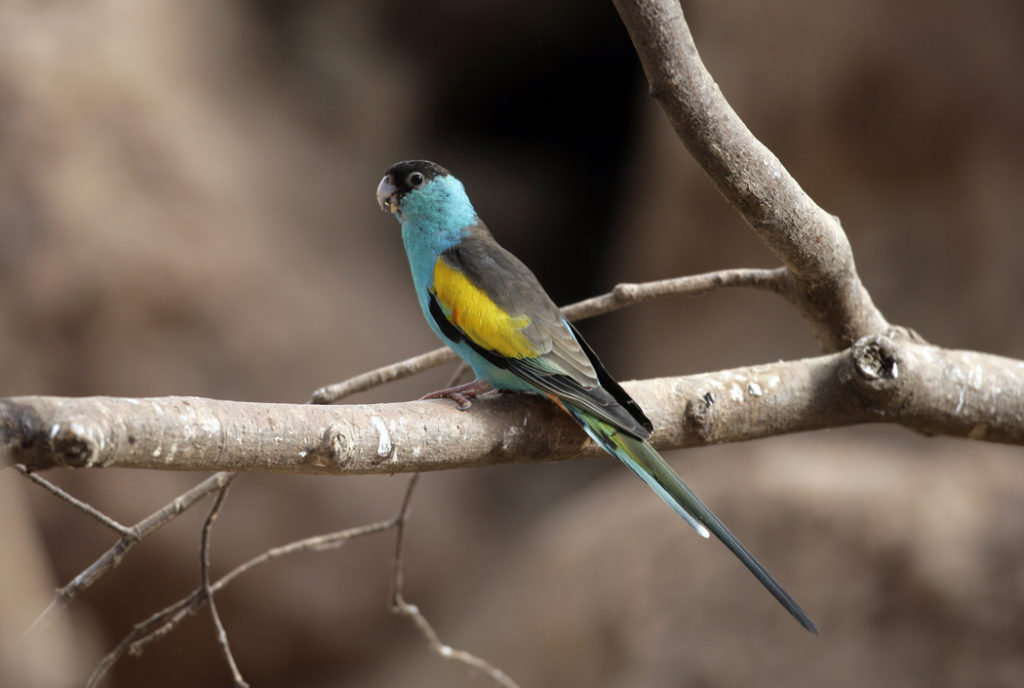
- Latin name: Psephotellus dissimilis
- Conservation Status: Least Concern
A close relative of the Goulden-shouldered parrot, the Hooded parrot is found in the arid and semi-arid areas of the Northern Territory. Like its golden-shouldered cousins, these parrots build their nests in termite mounds.
They live in Melaleuca woodlands, grasslands, and Eucalyptus woodlands along rivers, where they forage for seeds, fruit, and berries.
Paradise Parrot
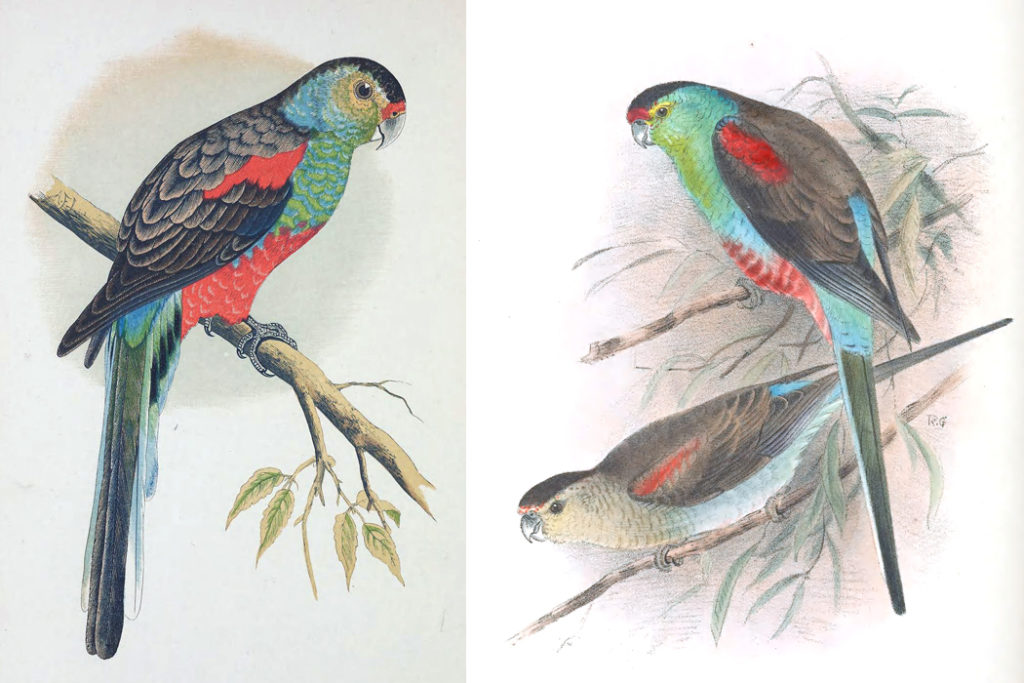
- Latin name: Psephotellus pulcherrimus
- Conservation Status: Most likely Extinct
The paradise parrot has the unfortunate distinction of being the only Australian parrot recorded “extinct” by the IUCN.
It lived in the grassy woodlands extending across Queensland and New South Wales. It used to be reasonably common, but there have been no sightings since 1927.
Tasman Parakeet
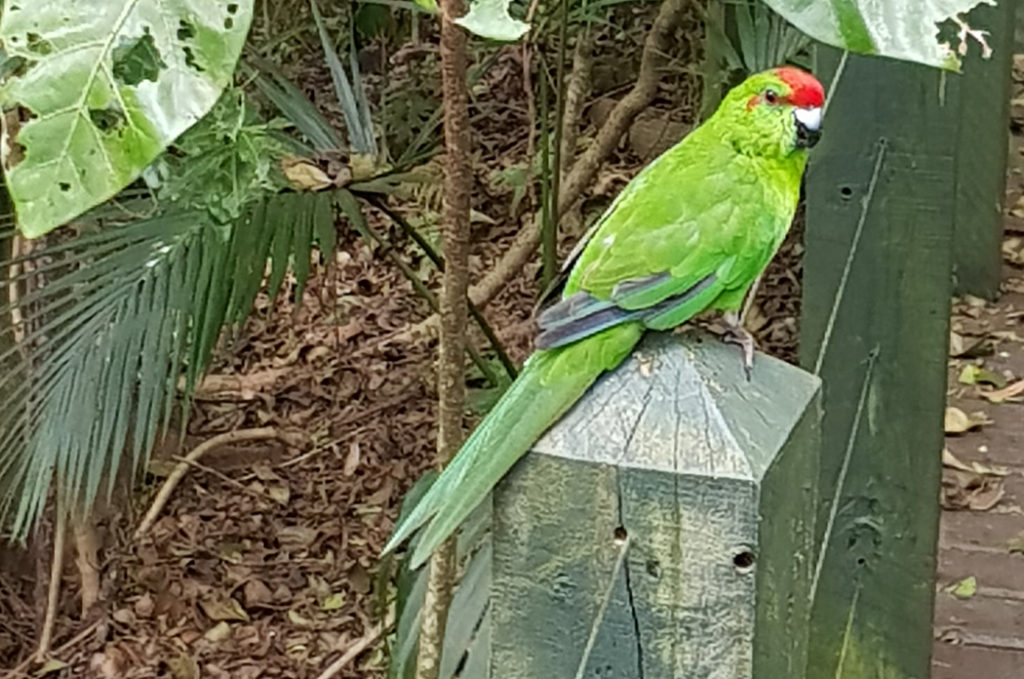
- Latin name: Cyanoramphus cookii
- Conservation Status: Endangered
The species’ other name, Norfolk parakeet is much more accurate – this parrot is endemic to Norfolk Island. And it has vanished from much of the island, except for Norfolk Island National Park.
Norfolk parakeets live in rainforests and venture out into surrounding orchards and farms. They feed mostly on seeds but also on fruit, berries and insects.
Red-crowned Parakeet
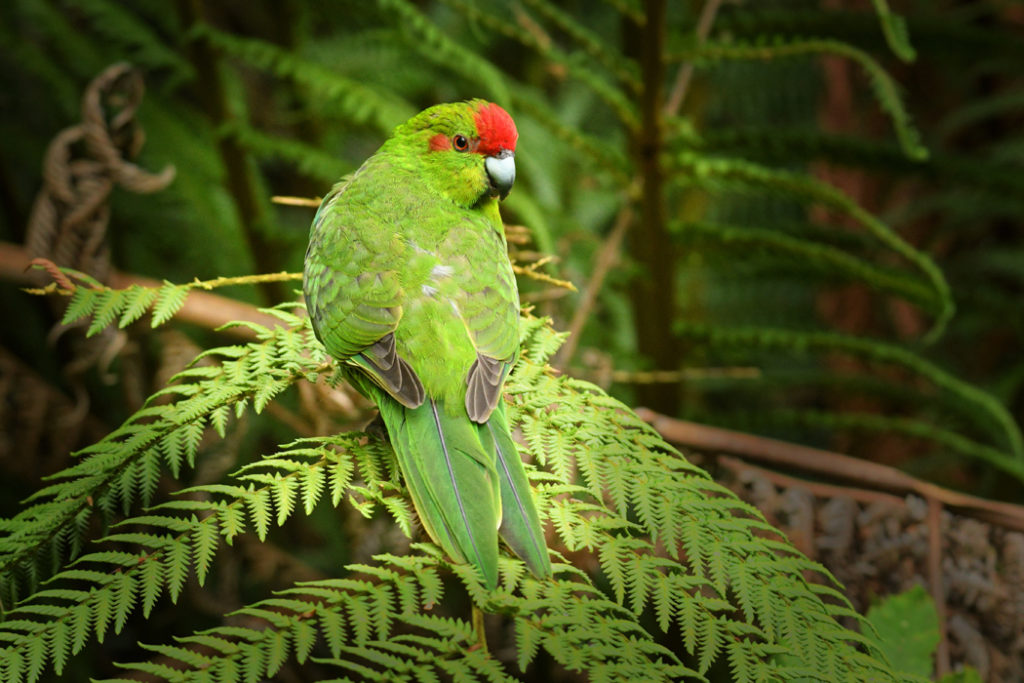
- Latin name: Cyanoramphus novaezelandiae
- Conservation Status: Extinct in Australia
The Red-fronted Parakeet is mostly a New Zealand species; however, in the past, one subspecies of this parrot – the Lord Howe Red-fronted parakeet was endemic to Lord Howe island, where it was last recorded in 1869.
Budgerigar
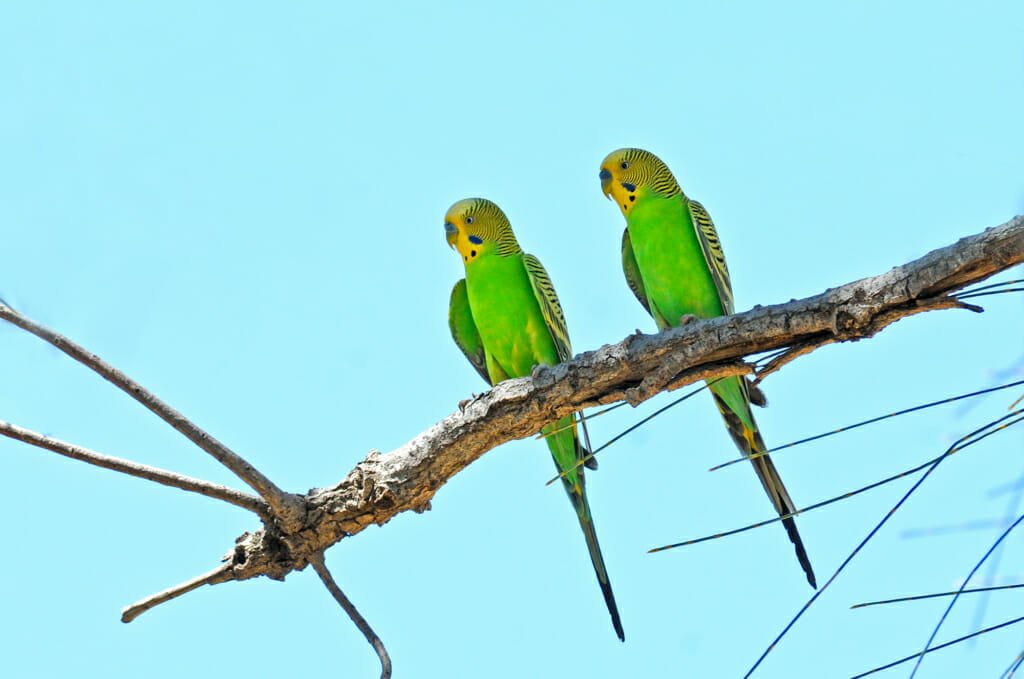
- Latin name: Melopsittacus undulatus
- Conservation Status: Least Concern
Probably the most well-known of all Australian parrots, Budgerigars are found throughout most of the Australian interior west of the Great Dividing Range.
Budgies are nomadic parrots moving from site to site in search of food and water. They prefer open habitats where they feed mostly on grass seeds. They typically move around in small flocks but can also congregate in huge flocks with many thousands of birds.
We saw budgerigars throughout the Red Center, including Western MacDonnell Ranges, Uluru, and Simpson desert.
Bourke’s Parrot
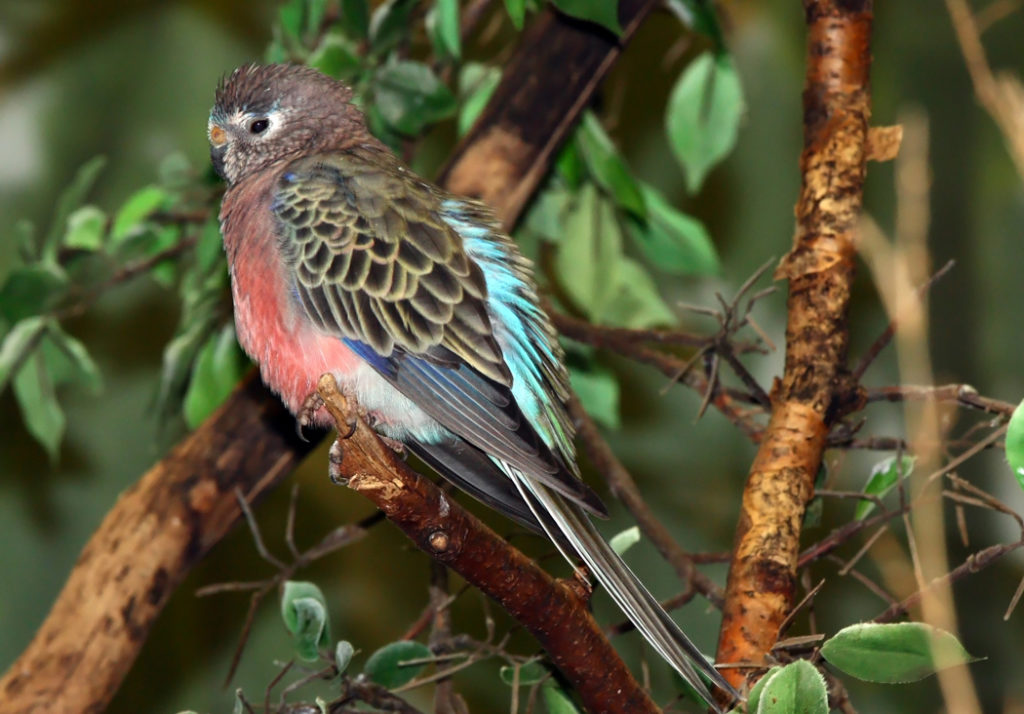
- Latin name: Neopsephotus bourkii
- Conservation Status: Least Concern
Compared to other parrots in Australia, Burke’s parrot’s plumage is rather subdued, with mostly grey tones. This species is widely distributed across arid and semi-arid Australia, where it is constantly on the move, following water and food sources. It prefers mulga and acacia scrubs and open woodlands where it feeds on seeds of grasses and herbs. So, it is found mostly on the ground.
At dawn and dusk, Burke’s parrots often congregate near water sources, and during a drought, it is not uncommon to see flocks of hundreds of birds.
Interestingly, I spent a year living in western New South Wales Outback but have never seen Burke’s parrots.
Blue-winged Parrot
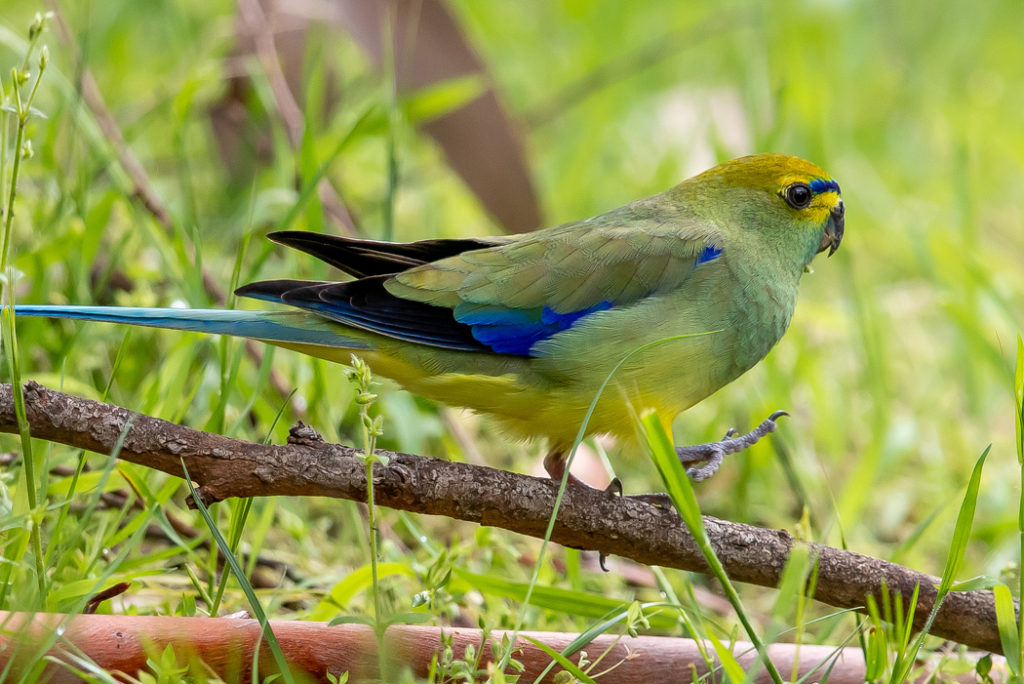
- Latin name: Neophema chrysostoma
- Conservation Status: Least Concern
The Blue-winged parrot is one of the most poorly known Australian parrots. Blue wings breed in Tasmania, and then most of them migrate to the mainland, while a few stay behind. Most of them migrate between central and eastern Tasmania and southern Victoria. Some populations are also found in western New South Wales and eastern South Australia.
They occur in a wide range of habitats where they forage mostly on seeds of grasses and herbs. They travel in pairs or small groups and are often found on the ground.
Elegant Parrot
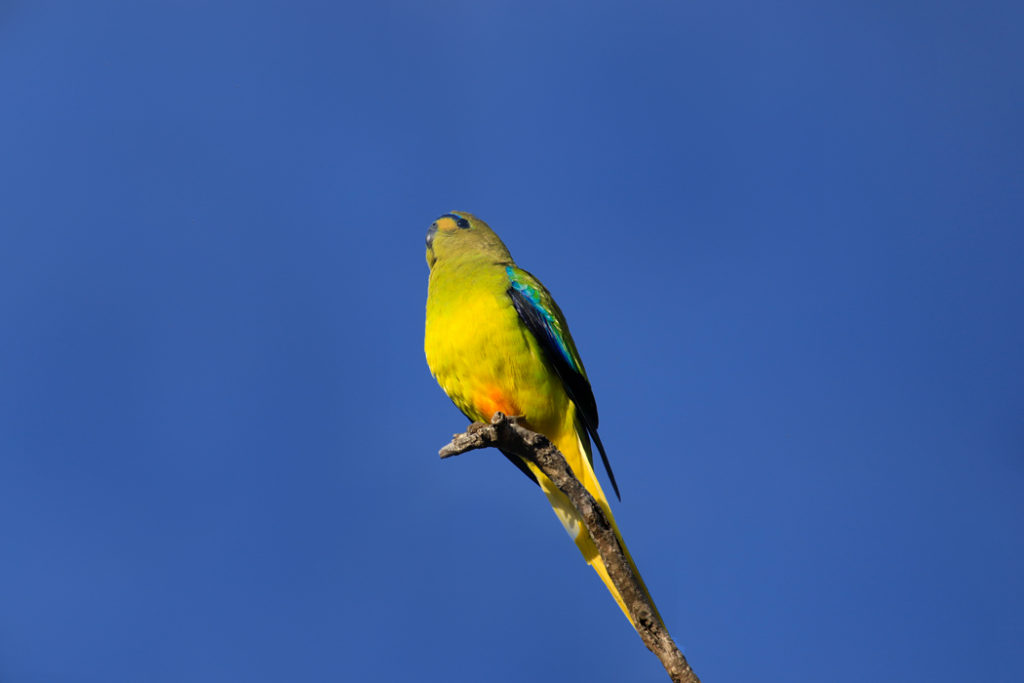
- Latin name: Neophema elegans
- Conservation Status: Least Concern
The Elegant parrot occurs in two distinct regions: in the southwest corner of Western Australia and in the southeast from western Victoria and southwestern New South Wales to eastern parts of South Australia, the Flinders Ranges and the Eyre Peninsula.
It is a migrant species that prefer open forests, woodlands, mallee, mulga, and salt marsh habitats where they forage for seeds of grasses and shrubs. They can also occasionally be seen on farmland. They feed mostly on the ground, sometimes in the company of Blue-winged parrots.
Rock Parrot
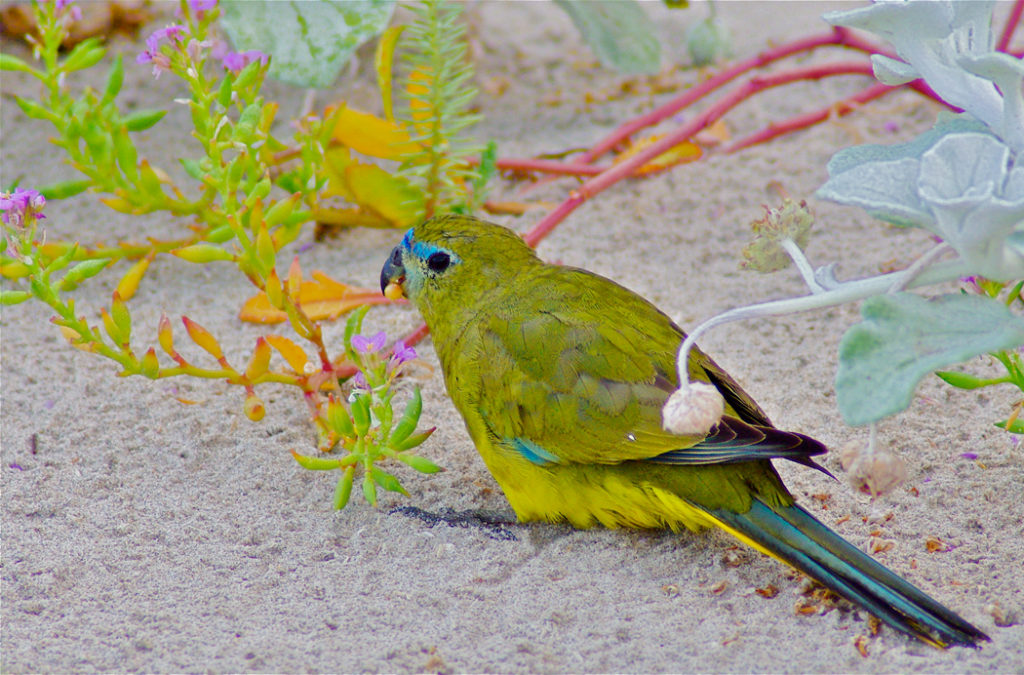
- Latin name: Neophema petrophila
- Conservation Status: Least Concern
The Rock parrot is confined to Australia’s southern coastline from South Australia to Western Australia. It is usually found within 100 meters of the shore, either on the rocky shores or on sandy beaches. They can be tricky to identify when they congregate into mixed flocks with similar-looking Elegant Parrots and Blue-winged Parrots.
These parrots feed on seeds and fruits, and it usually forages in the early morning and late afternoon. I saw Rock parrots in the coastal town of Elliston doing exactly that – foraging along the rocky shore early in the morning.
Orange-bellied Parrot
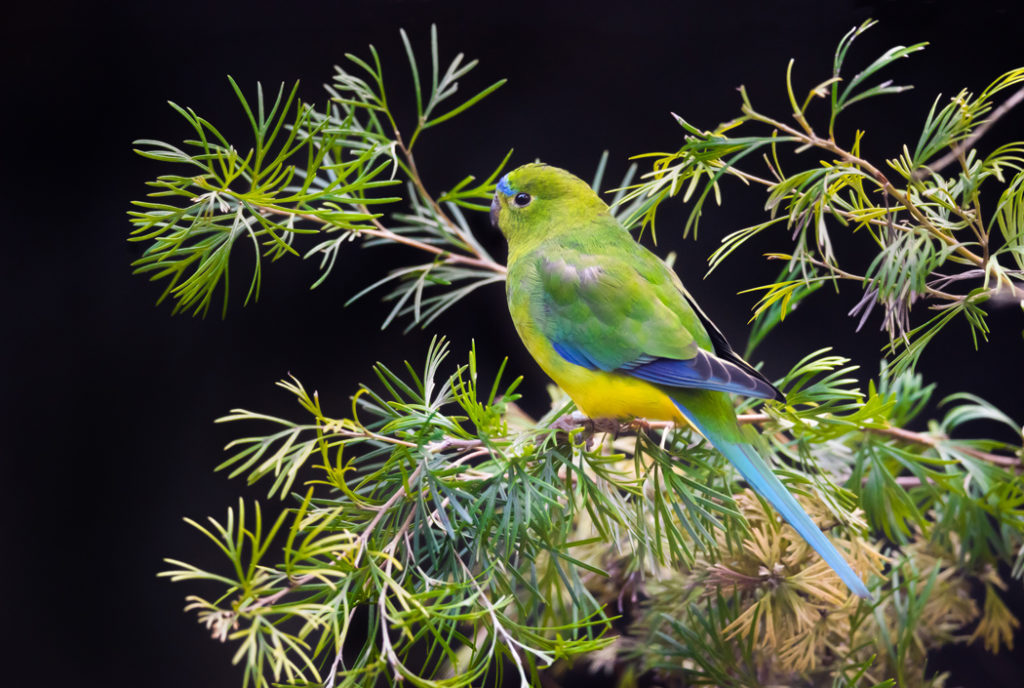
- Latin name: Neophema chrysogaster
- Conservation Status: Critically Endangered
The orange-bellied parrot is one of the most threatened parrots in Australia, with only 118 birds recorded in 2020. It is one of only three parrot species in Australia that migrate (the others are the Swift parrot and the Blue-winged parrot). They breed in remote southwest Tasmania and migrate to the coast of southern mainland Australia in winter.
They occur almost exclusively in coastal areas where they forage on seeds of salt marsh plants. These parrots mate for life and are usually seen foraging on the ground in pairs or in small flocks.
Turquoise Parrot

- Latin name: Neophema pulchella
- Conservation Status: Least Concern
The Turquoise parrot occurs in Eastern Australia, from southeastern Queensland to New South Wales and into Northeastern Victoria. These parrots prefer open woodland and savanna habitats where they forage mostly on seeds, fruit, nectar, flowers and insects.
They usually move around in pairs or small family groups, but they also may congregate in large flocks composed mainly of juvenile birds.
Scarlet-chested Parrot
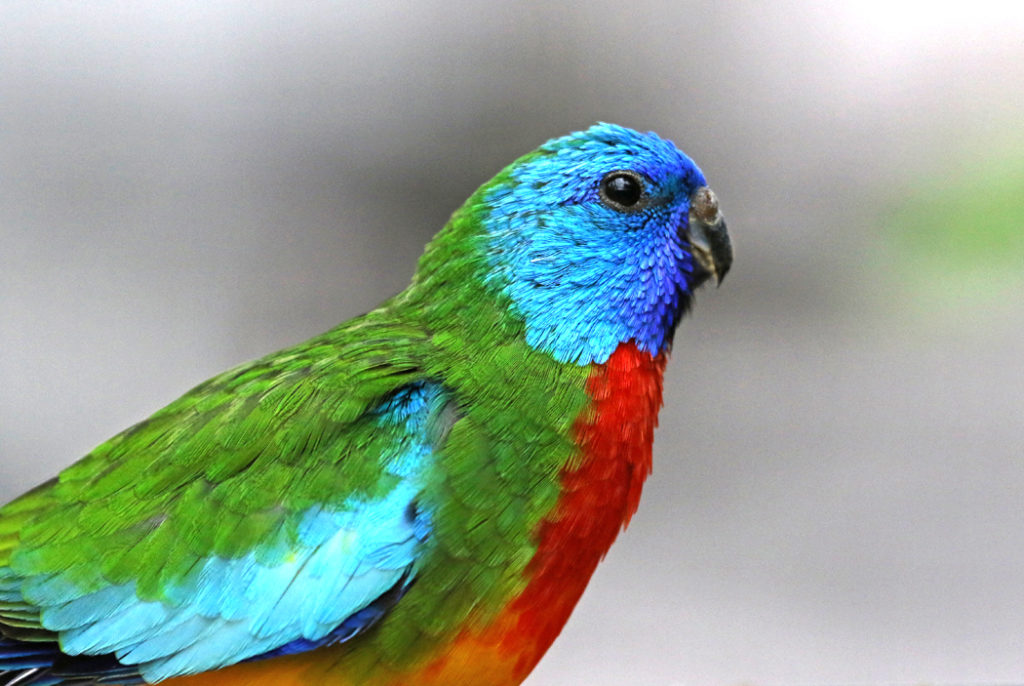
- Latin name: Neophema splendida
- Conservation Status: Least Concern
The rarely encountered Scarlet-chested parrots live in arid and semi-arid regions of southern Australia, where it is usually found in open woodlands of eucalypts, she-oak, mulga with spinifex and saltbush. It feeds primarily on grass seeds and thus can be seen on the ground or low in the shrubs.
They are frequently found far away from water sources, and the experts believe that they are able to obtain sufficient liquid by consuming succulent plants.
They usually occur in small groups but have also been observed congregating in larger flocks. I have seen a single female Scarlet-chested parrot at Scotia Wildlife Sanctuary in western New South Wales.
Eastern Ground Parrot
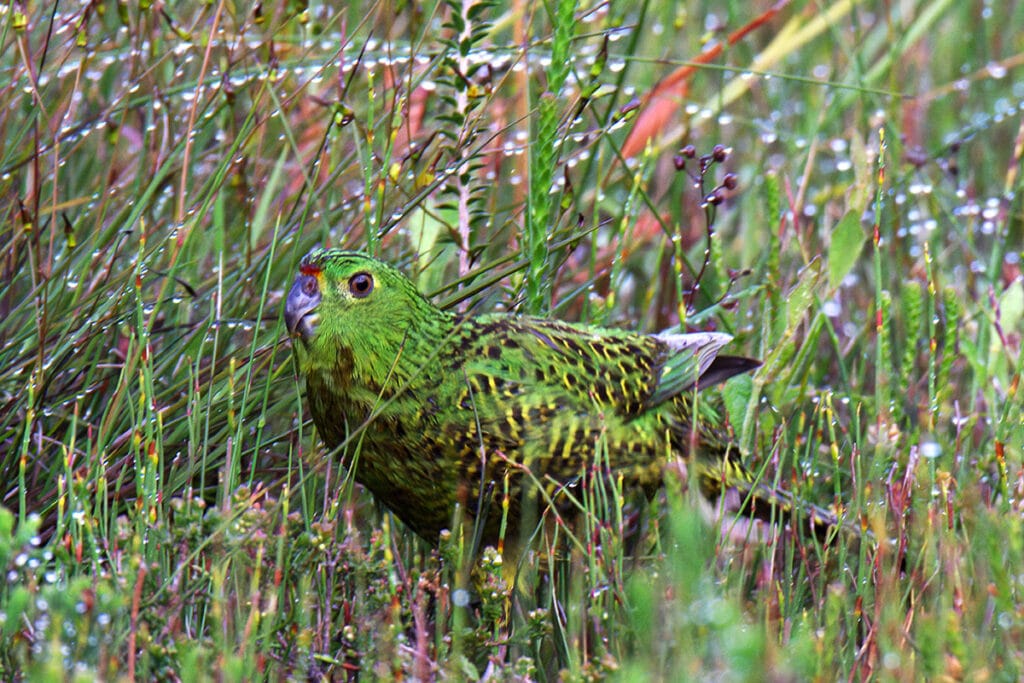
- Latin name: Pezoporus wallicus
- Conservation Status: Least Concern
The Ground parrot has a scattered distribution along the east coast of Australia, from southeast Queensland to coastal areas of Gippsland in Victoria and Tasmania. This parrot lives mostly in dense coastal habitats like heathlands and buttongrass plains, where they feed on seeds of grasses and shrubs.
A good place to look for the Eastern ground parrot is the Barren Grounds Nature Reserve in NSW Southern Highlands.
Western Ground Parrot
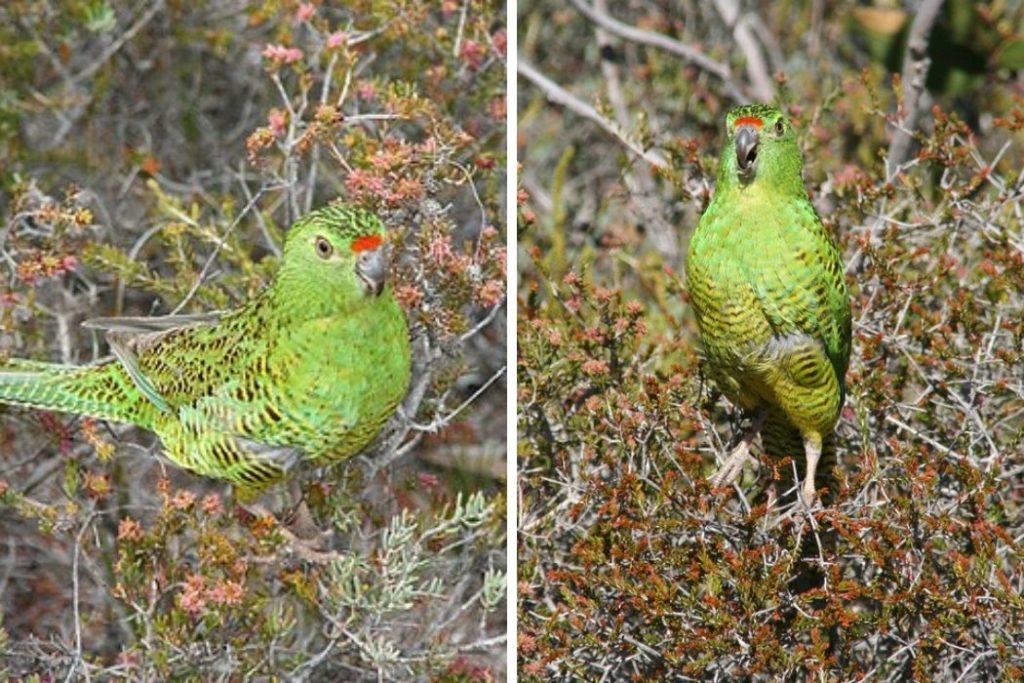
- Latin name: Pezoporus flaviventris
- Conservation Status: Not yet evaluated by IUCN. Critically Endangered in Australia
A close relative of the Eastern Ground Parrot, the Western Ground Parrot, is one of the rarest parrots in the world. It is restricted to Western Australia, where as few as 150 birds remain in the wild. The species is mostly restricted to a remote national park; however, in 2021- 2022, a few birds were translocated from Cape Arid to an area east of Albany to safeguard the population from wildfires.
Night Parrot
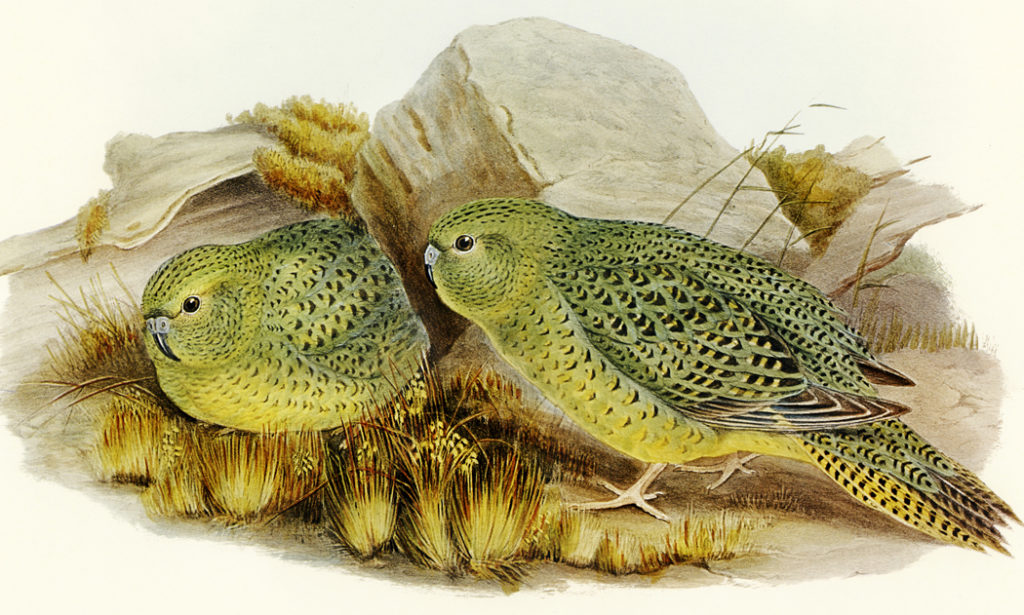
- Latin name: Pezoporus occidentalis
- Conservation Status: Endangered
Once thought extinct, the Night Parrot is often considered the ‘holy grail’ for birdwatchers and naturalists. There are no reliable population statistics for the Night parrot, but the experts estimate that there are between 50 and 249 mature individuals living in scattered populations in Australia’s inland regions.
This concludes my introduction to Australian parrots. They are an extraordinarily diverse group of birds, and spotting them in the wild is always a highlight of any wildlife adventures for me. Have you spotted many parrots in Australia? Leave your tips in the comments below.
More Wildlife Guides
- 13 Different Types of Bears and Where to See Them in the Wild
- Australian Animals – Guide to the Strangest Creatures on Earth
- When and Where to See Animals in the Wild: Guide to Wildlife Watching
- 5 Tips to Make a Wildlife Garden and Promote Biodiversity at Home
- Collective Nouns for Animals – Words You Need to Know for Your Next Safari
- Renaissance Cats in Florence – A Feline Lovers Guide to Florentine Renaissance Art
- Cheetah vs Leopard – How to Tell the Two Cats Apart
- All 40 Species of Wild Cats and Where to See Them in the Wild
- The 7 types of elephants and where to see them in the wild
- Amazing Wild Animals in Thailand And Where to See Them

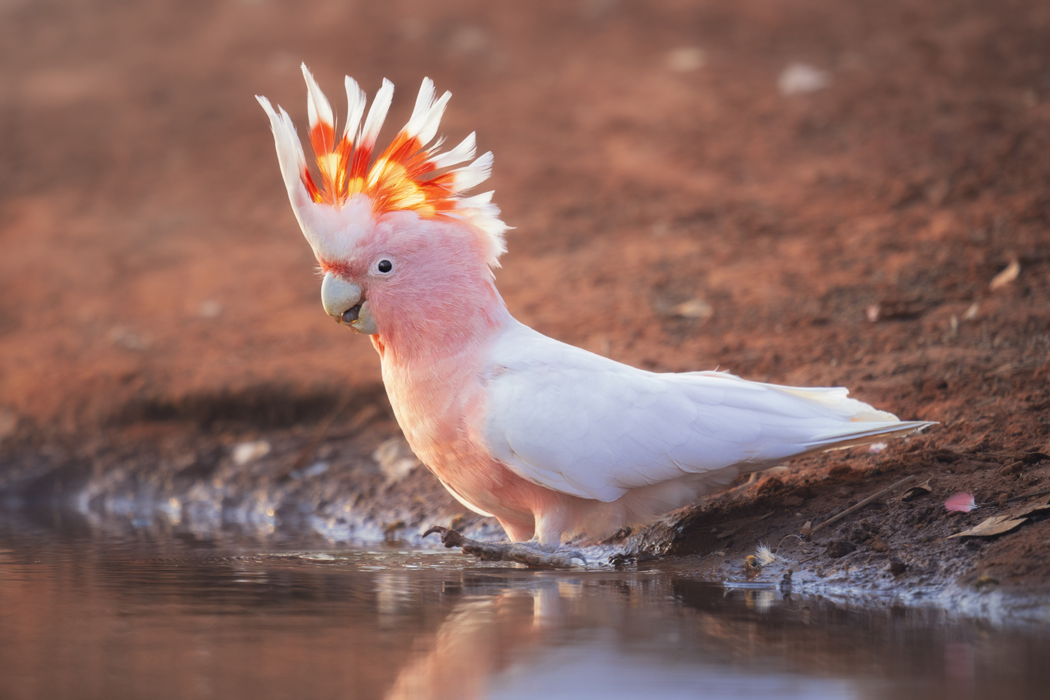
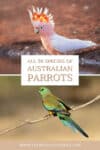
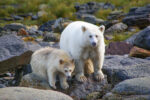
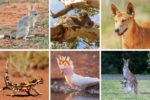
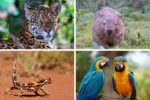

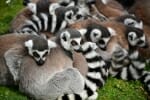


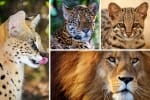

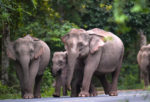
Hi Margarita,
Loved this article. Thankyou for this work. I breed budgies, have saved and released a Carnaby’s Cockatoo, and a Silver-eye. I just wanted to add, we have Red-Tails in inner Perth.
Hi Julia, thank you for dropping by and for sharing the tip on Red-tailed cockatoos in inner Perth! It’s a joy to meet another parrot aficionado!
Well compiled list however it does need updating. The Coconut Lorikeet is now a fully recognised species and is found on a number of Australian Torres Strait Islands. Also the extinct Macquarie Island Parakeet ought to have also got a mention. But still a great list.
Wow. Fabulous resource, thank you. A number of birds here that I saw not prolifically but regularly like the Crimson and Eastern Rosella throughout my childhood in the 80’s. I still see a pair of King parrots and a number of pale headed rosellas. Numerous Rainbows and Scaleys, not sure exact year this compiled but the conservation status of some really surprised me. Least concern and haven’t seen in SEQ in decades.
Thank you Leone! The conservation status in this guide is correct as at the end of 2022. The world we live in, with climate change and landscape alteration, species may move about quite a bit. So you may be seeing fewer of them in a given area but overall their conservation status hasn’t changed. Or their status simply hasn’t been recently assessed. From the species you mentioned, I would love to see a pale-headed rosella. I haven’t seem them yet
This is so awesome!! I thought I knew all the Australian keets but I did not know the Tasman or Rock. Thank You
Hi Margarita.
Wonderful resource you have provided here.
In a small Flickr group, an image of a parrot has been posted, provisionally ID’d as a Red-rumped parrot, except that its colouring is very light pastel shades. A juvenile?
If you have the time, can you help with the ID?
Here is the flickr image site:
https://www.flickr.com/photos/natures_image/52613576589/in/pool-photography_essentials/
Hi Peter, thank you for reaching out. While I am not an expert, I’d say it is definitely a male red-rumped parrot. I have seen different plumage variations in these birds here, in Sydney as well. Especially in females.
I’m not sure if it is a juvenile or just a slightly different morph. In Sydney, we have yellow King Parrots on Dangar Island, so I guess anything is possible :).
Hi my name is Elizabeth and I need help in ID of a parrot. This morning Boxing Day I heard a couple of parrots in a tree nearby (suburban Brisbane). A different call than my usual visitors. A parent and young. Cream head and chest, long slender body and longish tail. I did not have my glasses near by or my camera. As I was trying to get a good look the resident magpies chased them away. As they flew I caught a glimpse of orange on I think the under wings. This is not the first time they have visited and have been around a bit recently- heard mainly as I work from home and a quick glimpse twice. They are a little different having a cream head and cream chest and similar slender lorikeet sort of body.
I would appreciate you getting back to me as I am interested in our local wildlife (Holland Park, Brisbane). Email – [email protected]
Enjoy the Festive Season
Regards Elizabeth
Hi Elizabeth, cream head and chest doesn’t ring any bells. It might be a good idea to contact the local council. See if they have a bush care group or maybe some wildlife-related initiative. If they don’t have a record of these birds, they might be able to suggest a local birding enthusiast who might be able to help.
Margarita,
Your website is great with terrific information about so many subjects! Your Australian Parrot listing appeared on one of my feeds and I note your listing for Ground Parrots. You may wish to consider including a separate listing for the Western Ground Parrot, one of the World’s rarest parrots and the subject of a major conservation effort. You can find out more information at http://www.western-ground-parrot.org.au/
Thank you, Paul, for bringing the Western ground parrot to my attention. I am surprised to learn that it hasn’t been assessed by the IUCN, given how small the remaining population is. Has it not been formerly recognised as a distinct species yet by the IUCN? In any case it is heartwarming to see such a dedicated community of people caring for these parrots.